Substituted tryptamine


Substituted tryptamines, or simply tryptamines, also known as serotonin analogues (i.e., 5-hydroxytryptamine analogues), are organic compounds which may be thought of as being derived from tryptamine itself. The molecular structures of all tryptamines contain an indole ring system, joined to an amino (NH2) group via an ethyl (−CH2–CH2−) sidechain. In substituted tryptamines, the indole ring, sidechain, and/or amino group are modified by substituting another group for one of the hydrogen (H) atoms.
Well-known tryptamines include serotonin, an important neurotransmitter, and melatonin, a hormone involved in regulating the sleep-wake cycle. Tryptamine alkaloids are found in fungi, plants and animals; and sometimes used by humans for the neurological or psychotropic effects of the substance. Prominent examples of tryptamine alkaloids include psilocybin (from "psilocybin mushrooms") and DMT. In South America, dimethyltryptamine is obtained from numerous plant sources, like chacruna, and it is often used in ayahuasca brews. Many synthetic tryptamines have also been made, including the migraine drug sumatriptan, and psychedelic drugs. A 2022 study has found the variety of tryptamines present in wild mushrooms may affect the therapeutic impact.[1]
The tryptamine structure, in particular its indole ring, may be part of the structure of some more complex compounds, for example cyclized tryptamines like LSD, ibogaine, harmaline, mitragynine and yohimbine. A thorough investigation of dozens of tryptamine compounds was published by Alexander Shulgin and Ann Shulgin in 1997 under the title TiHKAL (Tryptamines I Have Known and Loved).[2]
Use and effects
[edit]The doses, potencies, durations, and effects of psychedelic tryptamines have been reviewed by Alexander Shulgin and other authors.[3][4][5][6][2][7][8][9][10][11]
Ring-unsubstituted tryptamines
[edit]| Compound | Chemical name | Dose | Duration | |
|---|---|---|---|---|
| Tryptamine (T) | Tryptamine | >100 mga | – | |
| NMT | N-Methyltryptamine | Unknownb | – | |
| NET | N-Ethyltryptamine | Unknown | Unknown | |
| NiPT | N-Isopropyltryptamine | Unknown | Unknown | |
| NsBT | N-sec-Butyltryptamine | 25–75 mg | "Short" | |
| NtBT | N-tert-Butyltryptamine | 5–20 mg | Unknown | |
| NAT | N-Amyltryptamine | >100 mg | – | |
| NHT | N-Hexyltryptamine | >100 mg | – | |
| DMT | N,N-Dimethyltryptamine | >350–1,000 mgc | – | |
| DET | N,N-Diethyltryptamine | 50–150 mg | 2–4 hours | |
| DPT | N,N-Dipropyltryptamine | 100–250 mg | 2–4 hours | |
| DiPT | N,N-Diisopropyltryptamine | 25–100 mg (15–150 mg+) | 4–8 hours | |
| DALT | N,N-Diallyltryptamine | 60–80 mg | <3 hours | |
| DBT | N,N-Dibutyltryptamine | ≥100 mg | Unknown | |
| DAT | N,N-Diamyltryptamine | Unknown | Unknown | |
| DHT | N,N-Dihexyltryptamine | >100 mg | – | |
| MET | N-Methyl-N-ethyltryptamine | 80–100 mg | Unknown | |
| MPT | N-Methyl-N-propyltryptamine | >50 mg | Unknown | |
| MiPT | N-Methyl-N-isopropyltryptamine | 10–25 mg | 3–4 hours | |
| MALT | N-Methyl-N-allyltryptamine | 25–50 mg | Unknown | |
| MBT | N-Methyl-N-butyltryptamine | 250–400 mg | 4–6 hours | |
| MsBT | N-Methyl-N-sec-butyltryptamine | 250–400 mg | Unknown | |
| EPT | N-Ethyl-N-propyltryptamine | Unknown | Unknown | |
| EiPT | N-Ethyl-N-isopropyltryptamine | 24–40 mg | 4–6 hours | |
| PiPT | N-Propyl-N-isopropyltryptamine | Unknown | Unknown | |
| Pyr-T | N,N-Tetramethylenetryptamine | Unknown | Unknown | |
| Pip-T | N,N-Pentamethylenetryptamine | Unknown | Unknown | |
| Mor-T | 3-(2-Morpholinoethyl)indole | Unknownd | Unknown | |
| Footnotes: a = Tryptamine is not orally active, but is active intravenously at a dose of 250 mg with a very short duration. b = NMT is not orally active, but is said to be active smoked at a dose of 50 to 120 mg with a duration of seconds to minutes. Also reportedly orally active with an MAOI. c = DMT is active parenterally at doses of 50 to 100 mg (2–100 mg) smoked, intramuscularly, or subcutaneously and at doses of 4 to 30 mg intravenously (bolus), with a duration of <1 hour or 5–20 minutes. For continuous intravenous infusion, the dose is 0.6 to 2.4 mg/minute. Also orally active with an MAOI (as in ayahuasca or pharmahuasca), with a typical dose of 50 mg (range 20–120 mg) and a duration of 4 to 6 hours. d = Mor-T was inactive at a dose of 30 mg by intramuscular injection. Refs: [3][4][2][7][8][9][11] Individual: [12][13][14][15][16][17][18][19][20][21][22][23] | ||||
4-Hydroxytryptamines
[edit]| Compound | Chemical name | Dose | Duration | |
|---|---|---|---|---|
| 4-HT (4-HO-T) | 4-Hydroxytryptamine | Unknown | Unknown | |
| Norbaeocystin (4-PO-T) | 4-Phosphoryloxytryptamine | Unknown | Unknown | |
| Norpsilocin (4-HO-NMT) | 4-Hydroxy-N-methyltryptamine | Unknown | Unknown | |
| Baeocystin (4-PO-NMT) | 4-Phosphoryloxy-N-methyltryptamine | 4–10 mga | Unknown | |
| Psilocin (4-HO-DMT) | 4-Hydroxy-N,N-dimethyltryptamine | 10–20 mg (5–40 mg+) | 3–6 hours | |
| Psilocybin (4-PO-DMT) | 4-Phosphoryloxy-N,N-dimethyltryptamine | 10–20 mg (5–40 mg+) | 3–6 hours | |
| 4-AcO-DMT (psilacetin) | 4-Acetoxy-N,N-dimethyltryptamine | Unknown | Unknown | |
| 4-PrO-DMT | 4-Propionyloxy-N,N-dimethyltryptamine | Unknown | Unknown | |
| 4-HO-DET (ethocin) | 4-Hydroxy-N,N-diethyltryptamine | 10–25 mg | 4–6 hours | |
| Ethocybin (4-PO-DET) | 4-Phosphoryloxy-N,N-diethyltryptamine | 15–30 mg | 4–6 hours | |
| 4-HO-DPT (deprocin) | 4-Hydroxy-N,N-dipropyltryptamine | >20 mg | 5–8 hours | |
| 4-HO-DiPT (iprocin) | 4-Hydroxy-N,N-diisopropyltryptamine | 12–20 mg (3–30 mg+) | 2–3 hours | |
| 4-AcO-DiPT (ipracetin) | 4-Acetoxy-N,N-diisopropyltryptamine | 6–10 mg | Unknown | |
| Luvesilocin (4-GO-DiPT) | 4-Glutaryloxy-N,N-diisopropyltryptamine | Unknownb | Unknownb | |
| 4-HO-DALT (daltocin) | 4-Hydroxy-N,N-diallyltryptamine | Unknown | Unknown | |
| 4-HO-DBT | 4-Hydroxy-N,N-dibutyltryptamine | >20 mg | Unknown | |
| 4-HO-DiBT | 4-Hydroxy-N,N-diisobutyltryptamine | >20 mg | Unknown | |
| 4-HO-DtBT | 4-HydroxyN,N-di-tert-butyltryptamine | Unknown | Unknown | |
| 4-HO-MET (metocin) | 4-Hydroxy-N-methyl-N-ethyltryptamine | 10–20 mg (2–45 mg+) | 4–6 hours | |
| 4-HO-MPT (meprocin) | 4-Hydroxy-N-methyl-N-propyltryptamine | 8–30 mg | Unknown | |
| 4-HO-MiPT (miprocin) | 4-Hydroxy-N-methyl-N-isopropyltryptamine | 12–25 mg (6–30 mg) | 4–6 hours | |
| 4-HO-MALT (maltocin) | 4-Hydorxy-N-methyl-N-allyltryptamine | Unknown | Unknown | |
| 4-HO-MtBT | 4-Hydroxy-N-methyl-N-tert-butyltryptamine | >15 mg | Unknown | |
| 4-HO-EPT (eprocin) | 4-Hydroxy-N-ethyl-N-propyltryptamine | Unknown | Unknown | |
| 4-HO-EiPT | 4-Hydroxy-N-ethyl-N-isopropyltryptamine | Unknown | Unknown | |
| 4-HO-PiPT (piprocin) | 4-Hydroxy-N-propyl-N-isopropyltryptamine | Unknown | Unknown | |
| 4-HO-TMT | 4-Hydroxy-N,N,N-trimethyltryptamine | Unknown | Unknown | |
| Aeruginascin (4-PO-TMT) | 4-Phosphoryloxy-N,N,N-trimethyltryptamine | Unknown | Unknown | |
| 4-HO-pyr-T | 4-Hydroxy-N,N-tetramethylenetryptamine | >20 mg | Unknown | |
| Footnotes: a = Baeocystin has conflicting reports, some say that it's active and some say that it's inactive. b = Luvesilocin is known to be active subcutaneously at doses of 5 to 40 mg with an average duration of 3.6 hours. Refs: [3][4][2][7][8][9][11] Individual: [14][15][24][25] | ||||
5-Hydroxytryptamines
[edit]| Compound | Chemical name | Dose | Duration | |
|---|---|---|---|---|
| Serotonin (5-HT, 5-HO-T) | 5-Hydroxytryptamine | >100 mga | – | |
| N-Methylserotonin (norbufotenin; 5-HO-NMT) | 5-Hydroxy-N-methyltryptamine | Unknown | Unknown | |
| Bufotenin (5-HO-DMT) | 5-Hydroxy-N,N-dimethyltryptamine | >100 mgb | – | |
| O-Acetylbufotenin (5-AcO-DMT) | 5-Acetoxy-N,N-dimethyltryptamine | Unknown | Unknown | |
| O-Pivalylbufotenin (5-t-BuCO-DMT) | 5-Pivaloxy-N,N-dimethyltryptamine | Unknown | Unknown | |
| 5-HO-DET | 5-Hydroxy-N,N-diethyltryptamine | Unknown | Unknown | |
| 5-HO-DPT (DiPS, NDPS) | 5-Hydroxy-N,N-dipropyltryptamine | Unknown | Unknown | |
| 5-HO-DiPT | 5-Hydroxy-N,N-diisopropyltryptamine | Unknown | Unknown | |
| Footnotes: a = Serotonin does not cross the blood–brain barrier and is not psychoactive. b = Bufotenin is not orally active, but is active intravenously at doses of 8 to 16 mg with a duration of 1 to 2 hours and is active via insufflation and other parenteral routes. Refs: [3][4][2][11] Individual: [26][27][28][29] | ||||
5-Methoxytryptamines
[edit]| Compound | Chemical name | Dose | Duration | |
|---|---|---|---|---|
| 5-MT (5-MeO-T) | 5-Methoxytryptamine | Unknown | Unknown | |
| 5-MeO-NMT | 5-Methoxy-N-methyltryptamine | Unknown | Unknown | |
| 5-MeO-NET | 5-Methoxy-N-ethyltryptamine | Unknown | Unknown | |
| 5-MeO-NiPT | 5-Methoxy-N-isopropyltryptamine | Unknown | Unknown | |
| 5-MeO-DMT (mebufotenin) | 5-Methoxy-N,N-dimethyltryptamine | >35 mga | – | |
| 5-MeO-DET | 5-Methoxy-N,N-diethyltryptamine | 1–3 mg | 3–4 hours | |
| 5-MeO-DPT | 5-Methoxy-N,N-dipropyltryptamine | 6–10 mg | 2–4 hours | |
| 5-MeO-DiPT | 5-Methoxy-N,N-diisopropyltryptamine | 6–12 mg | 4–8 hours | |
| 5-MeO-DALT | 5-Methoxy-N,N-diallyltryptamine | 12–25 mg | 2–4 hours | |
| 5-MeO-DBT | 5-Methoxy-N,N-dibutyltryptamine | Unknown | Unknown | |
| 5-MeO-DsBT | 5-Methoxy-N,N-di-sec-butyltryptamine | Unknown | Unknown | |
| 5-MeO-MET | 5-Methoxy-N-methyl-N-ethyltryptamine | Unknown | Unknown | |
| 5-MeO-MPT | 5-Methoxy-N-methyl-N-propyltryptamine | Unknown | Unknown | |
| 5-MeO-MiPT | 5-Methoxy-N-methyl-N-isopropyltryptamine | 4–6 mg (0.5–20 mg+) | 4–6 hours | |
| 5-MeO-MALT | 5-Methoxy-N-methyl-N-allyltryptamine | Unknown | Unknown | |
| 5-MeO-EPT | 5-Methoxy-N-ethyl-N-propyltryptamine | Unknown | Unknown | |
| 5-MeO-EiPT | 5-Methoxy-N-ethyl-N-isopropyltryptamine | Unknown | Unknown | |
| 5-MeO-PiPT | 5-Methoxy-N-propyl-N-isopropyltryptamine | Unknown | Unknown | |
| 5-MeO-iPALT (ASR-3001) | 5-Methoxy-N-isopropyl-N-allyltryptamine | 8–14 mg | 1.5–2.5 hours | |
| 5-MeO-pyr-T | 5-Methoxy-N,N-tetramethylenetryptamine | 0.5–2 mg | Several hours | |
| Melatonin (5-MeO-NAcT) | 5-Methoxy-N-acetyltryptamine | 1–10 mgb | A few hours | |
| Footnotes: a = 5-MeO-DMT is not orally active, but is active at a dose of 2 to 20 mg smoked or 2 to 3 mg intravenously, with a duration of 5 to 20 minutes. Also orally active with an MAOI at doses of 10 to 25 mg. b = Melatonin is not a psychedelic but a hypnotic and is non-hallucinogenic at doses of up to 1,200 mg. Refs: [3][4][2][7][8][9][11] Individual: [15][19] | ||||
α-Alkyltryptamines
[edit]| Compound | Chemical name | Dose | Duration | |
|---|---|---|---|---|
| AMT (α-methyl-T; Indopan)a | α-Methyltryptamine | 15–40 mg | 12–16 hours | |
| AET (α-ethyl-T; etryptamine; Monase)b | α-Ethyltryptamine | 100–160 mg | 6–8 hours | |
| α,N-DMT (N-methyl-AMT)c | α-Methyl-N-methyltryptamine | 50–100 mg | 6–8 hours | |
| α,N,N-TMT (N,N-dimethyl-AMT) | α,N,N-Trimethyltryptamine | Unknownd | Unknown | |
| 2,α-DMT (2-methyl-AMT) | 2-Methyl-α-methyltryptamine | 300–500 mg | 7–10 hours | |
| 4-HO-AMT (MP-14) | 4-Hydroxy-α-methyltryptamine | 15–20 mg+ | Unknown | |
| 4-Methyl-AMT (MP-809) | 4-Methyl-α-methyltryptamine | 20–60 mg+ | Unknown | |
| 5-Fluoro-AMT (PAL-212, PAL-544) | 5-Fluoro-α-methyltryptamine | 25 mg+ | >9 hours | |
| 5-Chloro-AMT (PAL-542) | 5-Chloro-α-methyltryptamine | Unknown | Unknown | |
| 5-Fluoro-AET (PAL-545) | 5-Fluoro-α-ethyltryptamine | Unknown | Unknown | |
| 5-Chloro-AET (PAL-526) | 5-Chloro-α-ethyltryptamine | Unknown | Unknown | |
| 6-Fluoro-AMT | 6-Fluoro-α-methyltryptamine | 25–75 mg | "Long" | |
| α-Methylserotonin (AMS; 5-HO-AMT) | α-Methyl-5-hydroxytryptamine | Unknown | Unknown | |
| α,O-DMS (5-MeO-AMT) | α-Methyl-5-methoxytryptamine | 2.5–5 mg (0.5–15 mg) | 12–18 hours | |
| α,N,O-TMS (5-MeO-N-methyl-AMT) | α-Methyl-5-methoxy-N-methyltryptamine | 10–20 mg | 6–8 hours | |
| α,N,N,O-TeMS (5-MeO-N,N-dimethyl-AMT) | 5-Methoxy-α,N,N-trimethyltryptamine | Unknown | Unknown | |
| 5-MeO-AET | α-Ethyl-5-methoxytryptamine | ~70 mg | Several hours | |
| Bk-NM-AMT (β-keto-N-methyl-AMT)e | α-Methyl-β-keto-N-methyltryptamine | Unknown | Unknown | |
| Footnotes: a = AMT is a not only a psychedelic but is also a stimulant and entactogen. b = AET is an entactogen and stimulant and is not a psychedelic. c = α,N-DMT is a stimulant and is not a psychedelic or entactogen. d = α,N,N-TMT has been reported to be an active psychedelic orally but to be much less potent than AMT. e = Bk-NM-AMT is expected to be an entactogen and stimulant but not a psychedelic. Refs: [3][4][2][7][8][11] Individual: [30][31] | ||||
Other tryptamines
[edit]| Compound | Chemical name | Dose | Duration | |
|---|---|---|---|---|
| Lespedamine (1-MeO-DMT) | 1-Methoxy-N,N-dimethyltryptamine | Unknown | Unknown | |
| 2-Methyl-DMT | 2-Methyl-N,N-dimethyltryptamine | 50–100 mg | 4–6 hours | |
| 2-Methyl-DET | 2-Methyl-N,N-diethyltryptamine | 80–120 mg | 6–8 hours | |
| 4-MeO-DMT | 4-Methoxy-N,N-dimethyltryptamine | Unknown | Unknown | |
| 4-MeO-DET | 4-Methoxy-N,N-diethyltryptamine | >30 mg | Unknown | |
| 4-MeO-DiPT | 4-Methoxy-N,N-diisopropyltryptamine | Unknown | Unknown | |
| 4-MeO-MiPT | 4-Methoxy-N-methyl-N-isopropyltryptamines | 20–30 mg | 4–6 hours | |
| 4,5-MDO-DMT | 4,5-Methylenedioxy-N,N-dimethyltryptamine | Unknown | Unknown | |
| 4,5-MDO-DiPT | 4,5-Methylenedioxy-N,N-diisopropyltryptamine | >25 mg | Unknown | |
| 5-Fluoro-DMT | 5-Fluoro-N,N-dimethyltryptamine | Unknown | Unknown | |
| 5-Chloro-DMT | 5-Chloro-N,N-dimethyltryptamine | Unknown | Unknown | |
| 5-Bromo-DMT | 5-Bromo-N,N-dimethyltryptamine | Unknowna | Unknown | |
| Bretisilocin (5-fluoro-MET) | 5-Fluoro-N-methyl-N-ethyltryptamine | Unknownb | Unknownb | |
| 5-MeO-2-TMT | 5-Methoxy-2-methyl-N,N-dimethyltryptamine | 75–150 mg | 5–10 hours | |
| 5-MeS-DMT | 5-Methylthio-N,N-dimethyltryptamine | Unknownc | Unknownc | |
| 5,6-MeO-MiPT | 5,6-Dimethoxy-N-methyl-N-isopropyltryptamine | >75 mg | Unknown | |
| 5,6-MDO-DMT | 5,6-Methylenedioxy-N,N-dimethyltryptamine | >5 mg | Unknown | |
| 5,6-MDO-DiPT | 5,6-Methylenedioxy-N,N-diisopropyltryptamine | Unknown | Unknown | |
| 5,6-MDO-MiPT | 5,6-Methylenedioxy-N-methyl-N-isopropyltryptamine | >50–60 mg | Unknown | |
| 6-Fluoro-DMT | 6-Fluoro-N,N-dimethyltryptamine | Unknown | Unknown | |
| 6-Fluoro-DET | 6-Fluoro-N,N-diethyltryptamine | >80 mg | Unknown | |
| 6-HO-DMT | 6-Hydroxy-N,N-dimethyltryptamine | >80 mg | Unknown | |
| 6-HO-DET | 6-Hydroxy-N,N-diethyltryptamine | ≥10 mgd | 3–4 hoursd | |
| 6-MeO-DMT | 6-Methoxy-N,N-dimethyltryptamine | Unknown | Unknown | |
| 6-MeO-DiPT | 6-Methoxy-N,N-diisopropyltryptamine | >50 mg | Unknown | |
| 6-MeO-MiPT | 6-Methoxy-N-methyl-N-isopropyltryptamine | >50 mg | Unknown | |
| 7-HO-DMT | 7-Hydroxy-N,N-dimethyltryptamine | Unknown | Unknown | |
| 7-MeO-DMT | 7-Methoxy-N,N-dimethyltryptamine | Unknown | Unknown | |
| 7-MeO-DiPT | 7-Methoxy-N,N-diisopropyltryptamine | >70 mg | Unknown | |
| 7-MeO-MiPT | 7-Methoxy-N-methyl-N-isopropyltryptamine | >70 mg | Unknown | |
| Footnotes: a = 5-Bromo-DMT is active via smoking at a dose of 20 to 50 mg. b = Bretisilocin is active intravenously with a dose range of 10 to 20 mg and a duration of 60 to 90 minutes. c = 5-MeS-DMT's oral dose and duration are unknown, but smoked the dose is 15 to 30 mg and the duration is 10 to 30 minutes or <1 hour. d = Controversial and uncertain. Refs: [3][4][2][9][11] Individual: [32][33][21] | ||||
Interactions
[edit]Pharmacology
[edit]Pharmacodynamics
[edit]| Compound | 5-HT1A | 5-HT1B | 5-HT1D | 5-HT1E | 5-HT2A | 5-HT2B | 5-HT2C | 5-HT3 | 5-HT5A | 5-HT6 | 5-HT7 | SERT |
|---|---|---|---|---|---|---|---|---|---|---|---|---|
| DMT | 269 | 447 | 117 | 380 | 380 | 112 | 257 | – | 2,090 | 275 | 69 | 2,400 |
| Psilocin | 372 | 191 | 98 | 339 | 200 | 25 | 245 | – | 447 | 79 | 87 | 2,570 |
| Psilocybin | 5,250 | – | 195 | – | 851 | 479 | 3,090 | – | – | 776 | – | – |
| 4-AcO-MALT | 977 | – | 871 | 417 | 692 | 25 | 631 | – | – | 661 | 794 | 3,090 |
| Bufotenin | 8.3 | 59 | 22 | 25 | 224 | 6.2 | 209 | 166 | 302 | 18 | 8.9 | 1,120 |
| 5-MeO-DMT | 10 | 91 | 21 | 575 | 200 | 15 | 490 | – | 589 | 25 | 4.4 | – |
| 5-MeO-DiPT | 170 | – | 871 | – | 324 | 46 | – | – | – | 2,190 | – | – |
| 5-MeO-DALT | 17 | 1,020 | 54 | 977 | 457 | 100 | 2,240 | – | – | 162 | 60 | 4,470 |
| 5-MeO-EiPT | 54 | 1,170 | 174 | – | 1,622 | 98 | – | – | – | 407 | 661 | 5,620 |
| LSD | 5.9 | 21 | 3.5 | 135 | 8.5 | 5.5 | 17 | – | 1.8 | 16 | 8.5 | – |
| Compound | 5-HT1A | 5-HT1B | 5-HT1D | 5-HT1E | 5-HT2A | 5-HT2B | 5-HT2C | 5-HT3 | 5-HT5A | 5-HT6 | 5-HT7 | SERT |
|---|---|---|---|---|---|---|---|---|---|---|---|---|
| DMT | >10,000 | >10,000 | 93 | 456 | 2,323 | 108 | 335 | >10,000 | 611 | 487 | 883 | 3,742 |
| DPT | 32 | 854 | 619 | 2,338 | 2,579 | 42 | 1,567 | >10,000 | 4,373 | 4,543 | 284 | 157 |
| DiPT | 121 | >10,000 | 3,742 | >10,000 | >10,000 | 399 | >10,000 | >10,000 | >10,000 | >10,000 | 3,423 | 1,258 |
| Psilocin | 63 | 305 | 19 | 44 | 340 | 4.7 | 141 | >10,000 | 70 | 72 | 72 | 852 |
| 5-MeO-DMT | 1.9 | 74 | 6.3 | 360 | 2,011 | 3,884 | 538 | >10,000 | 277 | 36 | 3.9 | 2,032 |
| 5-MeO-DiPT | 132 | 5,137 | 1,718 | >10,000 | >10,000 | 163 | >10,000 | >10,000 | >10,000 | >10,000 | 1,231 | 2,531 |
| 5-MeO-MiPT | 12 | 303 | 23 | 3,496 | 448 | 59 | 2,186 | >10,000 | 953 | 130 | 20 | 6,409 |
| 6-Fluoro-DMT | 393 | 218 | 55 | 461 | 866 | 30 | 674 | >10,000 | 961 | 26 | 41 | 145 |
| 5-MeO-TMT | 200 | >10,000 | 250 | 1,800 | >10,000 | ? | 4,020 | ? | 10,450 | 60 | 145 | >10,000 |
| EMDT | 170 | >10,000 | 290 | 520 | >10,000 | ? | 1,810 | ? | 4,620 | 16 | 300 | >10,000 |
| Ibogaine | >10,000 | >10,000 | >10,000 | ? | 14,142 | ? | >10,000 | >10,000 | ? | ? | ? | 549 |
| LSD | 7.3 | 3.9 | 7.8 | 93 | 11 | 30 | 31 | >10,000 | 9 | 6.9 | 6.6 | >10,000 |
Chemistry
[edit]Synthesis
[edit]The chemical syntheses of numerous tryptamines have been described by Alexander Shulgin in his book TiHKAL (Tryptamines I Have Known and Loved).[2] A well-known and widely used synthetic approach for making tryptamines is the Speeter–Anthony route, which starts with indole.[36][37][38] Other tryptamine synthesis routes have also been described, for instance starting with tryptamine rather than indole.[36][37]
List of substituted tryptamines
[edit]| Structure | Name | Origin | Ring sub. | RN1 | RN2 | Chemical name | CAS # |
|---|---|---|---|---|---|---|---|
 |
Tryptamine (T) | Animals, plants, fungi | H | H | H | 3-(2-aminoethyl)indole / 2-(1H-indol-3-yl)ethanamine | 61-54-1 |
 |
NMT | Plants | H | H | CH3 | N-methyltryptamine | 61-49-4 |
 |
2-HO-NMT | Plants | 2-OH | H | CH3 | 2-hydroxy-N-methyltryptamine | 106987-89-7 |
 |
5-MeO-NMT | Plants | 5-OCH3 | H | CH3 | 5-methoxy-N-methyltryptamine | 2009-03-2 |
 |
Serotonin (5-HT) | Animals, plants | 5-OH | H | H | 5-hydroxytryptamine | 50-67-9 |
 |
N-Methylserotonin (NMS; norbufotenin; 5-HO-NMT) | Plants | 5-OH | H | CH3 | 5-hydroxy-N-methyltryptamine | 1134-01-6 |
 |
Bufotenin (5-HO-DMT) | Animals, plants, fungi | 5-OH | CH3 | CH3 | 5-hydroxy-N,N-dimethyltryptamine | 487-93-4 |
 |
Bufotenidine (5-HTQ) | Amphibians | 5-O− | (CH3)3 | 3-[2-(trimethylazaniumyl)ethyl]-1H-indol-5-olate | 487-91-2 | |
 |
Bufoviridine (5-SO-DMT) | Amphibians | 5-SO | CH3 | CH3 | 5-sulfooxy-N,N-dimethyltryptamine | 16369-08-7 |
 |
Melatonin (5-MeO-NAcT) | Animals, plants, microbes | 5-OCH3 | H | O=C-CH3 | 5-methoxy-N-acetyltryptamine | 73-31-4 |
 |
N-Acetylserotonin (NAS; normelatonin; 5-HO-NAcT) | Animals | 5-OH | H | O=C-CH3 | 5-hydroxy-N-acetyltryptamine | 1210-83-9 |
 |
6-Hydroxymelatonin | Animals | 5-OCH3, 6-OH | H | O=C-CH3 | N-[2-(6-Hydroxy-5-methoxy-1H-indol-3-yl)ethyl]acetamide | 2208-41-5 |
 |
4-Hydroxytryptamine (4-HT) | Fungi | 4-OH | H | H | 4-hydroxytryptamine | 570-14-9 |
 |
4-HO-NMT | Fungi | 4-OH | H | CH3 | 4-hydroxy-N-methyltryptamine | 28363-70-4 |
 |
Psilocin (4-HO-DMT) | Fungi | 4-OH | CH3 | CH3 | 4-hydroxy-N,N-dimethyltryptamine | 520-53-6 |
 |
4-HO-TMT | Fungi | 4-OH | CH3 | CH3 | 4-hydroxy-N,N,N-trimethyltryptammonium | 262285-41-6 |
 |
Norbaeocystin (4-PO-T) | Fungi | 4-OPO3H2 | H | H | 4-phosphoryloxy-tryptamine | 21420-59-7 |
 |
Baeocystin (4-PO-NMT) | Fungi | 4-OPO3H2 | H | CH3 | 4-phosphoryloxy-N-methyl-tryptamine | 21420-58-6 |
 |
Psilocybin (4-PO-DMT) | Fungi | 4-OPO3H2 | CH3 | CH3 | 4-phosphoryloxy-N,N-dimethyltryptamine | 520-52-5 |
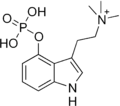 |
Aeruginascin (4-PO-TMT) | Fungi | 4-OPO3H2 | (CH3)3 | [3-[2-(trimethylazaniumyl)ethyl]-1H-indol-4-yl] hydrogen phosphate | 114264-95-8 | |
 |
DMT | Animals, plants | H | CH3 | CH3 | N,N-dimethyltryptamine | 61-50-7 |
 |
Lespedamine (1-MeO-DMT) | Plants | 1-OCH3 | CH3 | CH3 | 1-methoxy-N,N-dimethyltryptamine | 4335-93-7 |
 |
5-MeO-DMT (mebufotenin) | Animals, plants | 5-OCH3 | CH3 | CH3 | 5-methoxy-N,N-dimethyltryptamine | 1019-45-0 |
 |
5-Bromo-DMT | Marine sponges, invertebrates | 5-Br | CH3 | CH3 | 5-bromo-N,N-dimethyltryptamine | 17274-65-6 |
 |
6-Bromotryptamine | Marine invertebrates | 6-Br | H | H | 6-bromotryptamine | 96624-18-9 |
 |
5,6-Dibromotryptamine | Marine invertebrates | 5,6-Br | H | H | 5,6-dibromotryptamine | |
 |
5,6-Dibromo-NMT | Marine invertebrates | 5,6-Br | H | CH3 | 5,6-dibromo-N-methyltryptamine | |
 |
5,6-Dibromo-DMT | Marine sponges, invertebrates | 5,6-Br | CH3 | CH3 | 5,6-dibromo-N,N-dimethyltryptamine | 72853-80-6 |
 |
Desformylflustrabromine (dFBr) | Marine invertebrates | 2-(α,α-dimethylallyl), 6-Br | H | CH3 | 2-[6-bromo-2-(2-methylbut-3-en-2-yl)-1H-indol-3-yl]-N-methylethanamine | 474657-72-2 |
 |
Convolutindole A | Marine invertebrates | 2,4,6-Br, 1,7-OCH3 | CH3 | CH3 | 1,7-dimethoxy-2,4,6-tribromo-N,N-dimethyltryptamine | 443356-86-3 |
 |
Acetryptine (5-AT) | artificial | 5-COCH3 | H | H | 5-Acetyltryptamine | 3551-18-6 |
 |
5-BT | artificial | 5-OCH2C6H5 | H | H | 5-Benzyloxytryptamine | 20776-45-8 |
 |
5-CT | artificial | 5-CONH2 | H | H | 5-Carboxamidotryptamine | 74885-09-9 |
| 5-NOT | artificial | 5-O(CH2)8CH3 | H | H | 5-Nonyloxytryptamine | 157798-12-4 | |
 |
2-Methyl-5-hydroxytryptamine | artificial | 2-CH3, 5-OH | H | H | 3-(2-aminoethyl)-2-methyl-1H-indol-5-ol | 78263-90-8 |
 |
NET | artificial | H | H | CH2CH3 | N-ethyltryptamine | 61-53-0 |
 |
NiPT | artificial | H | H | CH(CH3)2 | N-isopropyltryptamine | 14121-10-9 |
 |
NcPT | artificial | H | H | C3H5 | N-cyclopropyltryptamine | |
 |
NsBT | artificial | H | H | CH(CH3)CH2CH3 | N-sec-butyltryptamine | |
 |
NtBT | artificial | H | H | C(CH3)3 | N-[2-(1H-indol-3-yl)ethyl]-2-methylpropan-2-amine | 1344092-44-9 |
 |
NAT | artificial | H | H | (CH2)4CH3 | N-[2-(1H-indol-3-yl)ethyl]pentan-1-amine | |
| NHT | artificial | H | H | (CH2)5CH3 | N-[2-(1H-indol-3-yl)ethyl]hexan-1-amine | ||
 |
N-Benzyltryptamine (NBnT) | artificial | H | H | CH2C6H5 | N-benzyltryptamine | 15741-79-4 |
 |
4-HO-NET | artificial | 4-OH | CH2CH3 | H | 4-hydroxy-N-ethyltryptamine | |
| 4-HO-NPT | artificial | 4-OH | CH(CH3)2 | H | 4-hydroxy-N-propyltryptamine | ||
 |
4-HO-NiPT | artificial | 4-OH | CH(CH3)2 | H | 4-hydroxy-N-isopropyltryptamine | |
 |
4-HO-NALT[39] | artificial | 4-OH | H | H2C=CH-CH2 | 4-hydroxy-N-allyltryptamine | |
| 4-HO-NBT (4-HO-NnBT) | artificial | 4-OH | H | (CH2)3CH3 | 4-hydroxy-N-n-butyltryptamine | ||
| 4-HO-NiBT | artificial | 4-OH | H | CH2CH(CH3)2 | 4-hydroxy-N-isobutyltryptamine | ||
| 4-HO-NsBT | artificial | 4-OH | H | CH(CH3)CH2CH3 | 4-hydroxy-N-sec-butyltryptamine | ||
| 4-HO-NtBT | artificial | 4-OH | H | C(CH3)3 | 4-hydroxy-N-tert-butyltryptamine | ||
 |
4-HO-NBnT | artificial | 4-OH | H | CH2C6H5 | 4-hydroxy-N-benzyltryptamine | |
| 4-HO-NcHT | artificial | 4-OH | H | C6H11 | 4-hydroxy-N-cyclohexyltryptamine | ||
 |
5-MeO-NBnT | artificial | 5-OCH3 | H | CH2C6H5 | 5-methoxy-N-benzyltryptamine | 25100-31-6 |
 |
5-MeO-T-NBOMe | artificial | 5-OCH3 | H | CH2C6H4(o-OCH3) | 5-methoxy-N-(ortho-methoxybenzyl)tryptamine | 1335331-37-7 |
 |
5-MT-NB3OMe [40] | artificial | 5-OCH3 | H | CH2C6H4(m-OCH3) | 5-methoxy-N-(meta-methoxybenzyl)tryptamine | 1648553-42-7 |
 |
5-MeO-NBpBrT | artificial | 5-OCH3 | H | CH2C6H4(p-Br) | N-(4-Bromobenzyl)-2-(5-methoxy-1H-indol-3-yl)ethanamine | 155639-13-7 |
 |
5-MeO-34MPEMT [41] | artificial | 5-OCH3 | CH3 | CH2CH2C6H3(p,m-OCH3) | N-methyl-N-[2-(3,4-dimethoxyphenyl)ethyl]-2-(5-methoxy-1H-indol-3-yl)ethanamine | |
| Idalopirdine | artificial | 6-F | H | CH2C6H4(m-OCH2CF2CF2H) | 2-(6-Fluoro-1H-indol-3-yl)-N-(3-(2,2,3,3-tetrafluoro-propoxy)benzyl)ethanamine | 467459-31-0 | |
 |
Z2876442907[42] | artificial | 4-CH3 | H | CH2(C3HNS)-COOCH2CH3 | ethyl 2-({[2-(4-methyl-1H-indol-3-yl)ethyl]amino}methyl)-1,3-thiazole-5-carboxylate | |
 |
Cis-2',5'-dimethyl-4-HO-azt-T [43] | artificial | 4-OH | cis-(CHCH3)CH2(CHCH3) | 3-{2-[(2R,4S)-2,4-dimethylazetidin-1-yl]ethyl}-1H-indol-4-ol | ||
 |
Pyr-T | artificial | H | (CH2)4 | 3-[2-(Pyrrolidin-1-yl)ethyl]-1H-indole | 14008-96-9 | |
 |
4-HO-pyr-T | artificial | 4-OH | (CH2)4 | 3-[2-(Pyrrolidin-1-yl)ethyl]-1H-indol-4-ol | 63097-26-7 | |
 |
Cis-2',5'-dimethyl-4-HO-pyr-T [43] | artificial | 4-OH | cis-(CHCH3)CH2CH2(CHCH3) | 3-{2-[(2R,5S)-2,5-dimethylpyrrolidin-1-yl]ethyl}-1H-indol-4-ol | ||
 |
5-MeO-pyr-T | artificial | 5-OCH3 | (CH2)4 | 5-Methoxy-3-[2-(pyrrolidin-1-yl)ethyl]-1H-indole | 3949-14-2 | |
 |
4-F-5-MeO-pyr-T | artificial | 4-F-5-OCH3 | (CH2)4 | 4-Fluoro-5-methoxy-3-(2-pyrrolidin-1-ylethyl)-1H-indole | 344790-93-8 | |
 |
Pip-T | artificial | H | (CH2)5 | 3-(2-Piperidin-1-ylethyl)-1H-indole | 26628-87-5 | |
 |
5-MeO-pip-T | artificial | 5-OCH3 | (CH2)5 | 5-Methoxy-3-(2-piperidin-1-ylethyl)-1H-indole | ||
| Mor-T | artificial | H | ? | 3-[2-(Morpholin-4-yl)ethyl]-1H-indole | 25262-59-3 | ||
| 5-MeO-mor-T | artificial | 5-OCH3 | ? | 5-Methoxy-3-[2-(morpholin-4-yl)ethyl]-1H-indole | 3949-13-1 | ||
 |
5-MeO-IsoqT | artificial | 5-OCH3 | ? | 3-[2-(2-Azabicyclo[2.2.2]octan-2-yl)ethyl]-5-methoxy-1H-indole | ||
 |
Indolylethylfentanyl | artificial | H | (CH2)5-4-N(COCH2CH3)C6H5 | N-[1-[2-(1H-indol-3-yl)ethyl]piperidin-4-yl]-N-phenylpropanamide | 58399-46-5 | |
 |
MET | artificial | H | CH3 | CH2CH3 | N-Methyl-N-ethyltryptamine | 5599-69-9 |
 |
MPT | artificial | H | CH3 | CH2CH2CH3 | N-Methyl-N-propyltryptamine | 850032-72-3 |
 |
MiPT | artificial | H | CH3 | CH(CH3)2 | N-Methyl-N-isopropyltryptamine | 96096-52-5 |
 |
McPT | artificial | H | CH3 | C3H5 | N-Methyl-N-cyclopropyltryptamine | 1373918-63-8 |
 |
EcPT | artificial | H | CH2CH3 | C3H5 | N-ethyl-N-cyclopropyltryptamine | |
 |
PcPT | artificial | H | CH2CH2CH3 | C3H5 | N-propyl-N-cyclopropyltryptamine | |
 |
iPcPT | artificial | H | CH(CH3)2 | C3H5 | N-isopropyl-N-cyclopropyltryptamine | |
 |
DcPT | artificial | H | C3H5 | C3H5 | N,N-dicyclopropyltryptamine | 1373918-62-7 |
 |
MBT | artificial | H | CH3 | (CH2)3CH3 | N-Methyl-N-butyltryptamine | 848130-12-1 |
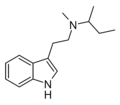 |
MsBT | artificial | H | CH3 | CH(CH3)CH2CH3 | N-Methyl-N-sec-butyltryptamine | |
 |
MiBT | artificial | H | CH3 | CH2CH(CH3)2 | N-Methyl-N-iso-butyltryptamine | |
 |
McPMT | artificial | H | CH3 | CH2C3H5 | N-Methyl-N-(cyclopropylmethyl)tryptamine | |
 |
DET | artificial | H | CH2CH3 | CH2CH3 | N,N-diethyltryptamine | 61-51-8 |
 |
EPT | artificial | H | CH2CH3 | CH2CH2CH3 | N-Ethyl-N-propyltryptamine | 850032-68-7 |
 |
EiPT | artificial | H | CH2CH3 | CH(CH3)2 | N-Ethyl-N-isopropyltryptamine | 848130-11-0 |
 |
DPT | artificial | H | CH2CH2CH3 | CH2CH2CH3 | N,N-dipropyltryptamine | 61-52-9 |
 |
PiPT | artificial | H | CH2CH2CH3 | CH(CH3)2 | N-Propyl-N-isopropyltryptamine | 1354632-00-0 |
 |
DiPT | artificial | H | CH(CH3)2 | CH(CH3)2 | N,N-diisopropyltryptamine | 14780-24-6 |
 |
EBT | artificial | H | CH2CH3 | (CH2)3CH3 | N-ethyl-N-butyltryptamine | |
 |
PBT | artificial | H | CH2CH2CH3 | (CH2)3CH3 | N-propyl-N-butyltryptamine | |
 |
iPsBT | artificial | H | CH(CH3)2 | CH(CH3)CH2CH3 | N-isopropyl-N-sec-butyltryptamine | |
 |
DBT | artificial | H | (CH2)3CH3 | (CH2)3CH3 | N,N-dibutyltryptamine | 15741-77-2 |
 |
DiBT | artificial | H | CH2CH(CH3)2 | CH2CH(CH3)2 | N,N-diisobutyltryptamine | 63938-64-7 |
 |
DsBT | artificial | H | CH(CH3)CH2CH3 | CH(CH3)CH2CH3 | N,N-disecbutyltryptamine | |
 |
DAT | artificial | H | (CH2)4CH3 | (CH2)4CH3 | N,N-diamyltryptamine | |
 |
DHT | artificial | H | (CH2)5CH3 | (CH2)5CH3 | N,N-dihexyltryptamine | |
 |
MALT | artificial | H | CH3 | H2C=CH-CH2 | N-methyl-N-allyltryptamine | 1366416-29-6 |
 |
DALT | artificial | H | H2C=CH-CH2 | H2C=CH-CH2 | N,N-diallyltryptamine | 60676-77-9 |
 |
PALT | artificial | H | H2C=CH-CH2 | CH2CH2CH3 | N-propyl-N-allyltryptamine | 2686297-71-0 |
 |
iPALT (ALiPT) | artificial | H | H2C=CH-CH2 | CH(CH3)2 | N-allyl-N-isopropyltryptamine | |
 |
1-Methyl-DMT | artificial | 1-CH3 | CH3 | CH3 | 1-methyl-N,N-dimethyltryptamine | 13366-47-7 |
 |
2-Methyl-DMT | artificial | 2-CH3 | CH3 | CH3 | (2-(2-methyl-1H-indol-3-yl)-1-methyl-ethyl)dimethylamine | 1080-95-1 |
 |
2-Methyl-DET | artificial | 2-CH3 | CH2CH3 | CH2CH3 | N,N-Diethyl-2-(2-methyl-1H-indol-3-yl)ethan-1-amine | 26628-88-6 |
| 2-Methyl-DiPT | artificial | 2-CH3 | CH(CH3)2 | CH(CH3)2 | 2-methyl-N,N-diisopropyltryptamine | ||
 |
2-Methyl-iPALT | artificial | 2-CH3 | CH(CH3)2 | H2C=CH-CH2 | 2-methyl-N-isopropyl-N-allyltryptamine | 2915652-49-0 |
 |
4-Amino-DMT [44] | artificial | 4-NH2 | CH3 | CH3 | 4-amino-N,N-dimethyltryptamine | 60331-61-5 |
 |
4-Methyl-DMT | artificial | 4-CH3 | CH3 | CH3 | 4,N,N-trimethyltryptamine | 28289-23-8 |
 |
4-MeO-DMT | artificial | 4-OCH3 | CH3 | CH3 | 4-methoxy-N,N-dimethyltryptamine | 3965-97-7 |
 |
4-MeO-DET | artificial | 4-OCH3 | CH2CH3 | CH2CH3 | 4-methoxy-N,N-diethyltryptamine | |
 |
4-MeO-MiPT | artificial | 4-OCH3 | CH3 | CH(CH3)2 | 4-methoxy-N-methyl-N-isopropyltryptamine | 96096-53-6 |
 |
4-MeO-DiPT | artificial | 4-OCH3 | CH(CH3)2 | CH(CH3)2 | 4-methoxy-N,N-diisopropyltryptamine | |
 |
4-AcO-DMT | artificial | 4-OCOCH3 | CH3 | CH3 | 4-acetoxy-N,N-dimethyltryptamine | 92292-84-7 |
 |
4-PrO-DMT | artificial | 4-OCOCH2CH3 | CH3 | CH3 | 4-propionyloxy-N,N-dimethyltryptamine | 1373882-11-1 |
 |
4-GO-DMT (RE109; FT-109) | artificial | 4-OCO(CH2)3COOH | CH3 | CH3 | 4-glutaryloxy-N,N-dimethyltryptamine | |
 |
4-HO-MET | artificial | 4-OH | CH3 | CH2CH3 | 4-hydroxy-N-methyl-N-ethyltryptamine | 77872-41-4 |
 |
4-AcO-MET | artificial | 4-OCOCH3 | CH3 | CH2CH3 | 4-acetoxy-N-methyl-N-ethyltryptamine | 1445751-40-5 |
 |
4-PO-MET | artificial | 4-OPO3H2 | CH3 | CH2CH3 | 4-phosphoryloxy-N-methyl-N-ethyltryptamine | |
 |
4-HO-DET | artificial | 4-OH | CH2CH3 | CH2CH3 | 4-hydroxy-N,N-diethyltryptamine | 22204-89-3 |
 |
4-AcO-DET | artificial | 4-OCOCH3 | CH2CH3 | CH2CH3 | 4-acetoxy-N,N-diethyltryptamine | 1135424-15-5 |
 |
4-PO-DET | artificial | 4-OPO3H2 | CH2CH3 | CH2CH3 | 4-phosphoryloxy-N,N-diethyltryptamine | 60480-02-6 |
 |
4-HO-EPT | artificial | 4-OH | CH2CH3 | CH2CH2CH3 | 4-hydroxy-N-ethyl-N-propyltryptamine | 2595431-59-5 |
 |
4-PO-EPT | artificial | 4-OPO3H2 | CH2CH3 | CH2CH2CH3 | 4-phosphoryloxy-N-ethyl-N-propyltryptamine | |
 |
4-AcO-EiPT | artificial | 4-OCOCH3 | CH2CH3 | CH(CH3)2 | 4-acetoxy-N-ethyl-N-isopropyltryptamine | |
 |
4-HO-MPT | artificial | 4-OH | CH3 | CH2CH2CH3 | 4-hydroxy-N-methyl-N-propyltryptamine | 763035-03-6 |
 |
4-HO-MiPT | artificial | 4-OH | CH(CH3)2 | CH3 | 4-hydroxy-N-isopropyl-N-methyltryptamine | 77872-43-6 |
 |
4-AcO-MiPT | artificial | 4-OCOCH3 | CH3 | CH(CH3)2 | 4-acetoxy-N-methyl-N-isopropyltryptamine | 1024612-25-6 |
 |
4-HO-MALT[45] | artificial | 4-OH | CH3 | H2C=CH-CH2 | 4-hydroxy-N-methyl-N-allyltryptamine | |
 |
4-AcO-MALT[46] | artificial | 4-OCOCH3 | CH3 | H2C=CH-CH2 | 4-acetoxy-N-Methyl-N-allyltryptamine | |
| 4-HO-iPALT | artificial | 4-OH | CH(CH3)2 | H2C=CH-CH2 | 4-hydroxy-N-isopropyl-N-allyltryptamine | ||
 |
4-HO-MBT | artificial | 4-OH | (CH2)3CH3 | CH3 | 4-hydroxy-N-butyl-N-methyltryptamine | |
 |
4-HO-MsBT | artificial | 4-OH | CH(CH3)CH2CH3 | CH3 | 4-hydroxy-N-sec-butyl-N-methyltryptamine | |
| 4-HO-MtBT | artificial | 4-OH | C(CH3)3 | CH3 | 4-hydroxy-N-tert-butyl-N-methyltryptamine | ||
 |
4-HO-EiBT | artificial[47] | 4-OH | CH2CH(CH3)2 | CH2CH3 | 4-hydroxy-N-iso-butyl-N-ethyltryptamine | |
 |
4-HO-McPT | artificial | 4-OH | C3H5 | CH3 | 4-hydroxy-N-cyclopropyl-N-methyltryptamine | 2883663-05-4 |
 |
4-HO-McPeT | artificial | 4-OH | C5H9 | CH3 | 4-hydroxy-N-cyclopentyl-N-methyltryptamine | 77872-48-1 |
 |
4-HO-McPMT [48] | artificial | 4-OH | CH2C3H5 | CH3 | 4-hydroxy-N-cyclopropylmethyl-N-methyltryptamine | |
 |
4-HO-DPT | artificial | 4-OH | CH2CH2CH3 | CH2CH2CH3 | 4-hydroxy-N,N-dipropyltryptamine | 63065-88-3 |
 |
4-AcO-DPT | artificial | 4-OCOCH3 | CH2CH2CH3 | CH2CH2CH3 | 4-acetoxy-N,N-dipropyltryptamine | 1445751-75-6 |
 |
4-HO-PiPT | artificial | 4-OH | CH2CH2CH3 | CH(CH3)2 | 4-hydroxy-N-propyl-N-isopropyltryptamine | |
 |
4-AcO-PiPT | artificial | 4-OCOCH3 | CH2CH2CH3 | CH(CH3)2 | 4-acetoxy-N-propyl-N-isopropyltryptamine | |
 |
4-HO-DiPT | artificial | 4-OH | CH(CH3)2 | CH(CH3)2 | 4-hydroxy-N,N-diisopropyltryptamine | 132328-45-1 |
 |
4-AcO-DiPT | artificial | 4-OCOCH3 | CH(CH3)2 | CH(CH3)2 | 4-acetoxy-N,N-diisopropyltryptamine | 936015-60-0 |
 |
4-PrO-DiPT | artificial | 4-OCOCH2CH3 | CH(CH3)2 | CH(CH3)2 | 4-propionyloxy-N,N-diisopropyltryptamine | 1373882-13-3 |
 |
Luvesilocin (RE104; FT-104) | artificial | 4-OCO(CH2)3COOH | CH(CH3)2 | CH(CH3)2 | 4-glutaryloxy-N,N-diisopropyltryptamine | |
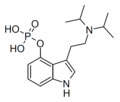 |
4-PO-DiPT | artificial | 4-OPO3H2 | CH(CH3)2 | CH(CH3)2 | 4-phosphoryloxy-N,N-diisopropyltryptamine | 1373882-09-7 |
 |
4-HO-DALT | artificial | 4-OH | H2C=CH-CH2 | H2C=CH-CH2 | 4-hydroxy-N,N-diallyltryptamine | 2173386-70-2 |
 |
4-AcO-DALT | artificial | 4-OCOCH3 | H2C=CH-CH2 | H2C=CH-CH2 | 4-acetoxy-N,N-diallyltryptamine | 1445751-71-2 |
 |
4-HO-DBT | artificial | 4-OH | (CH2)3CH3 | (CH2)3CH3 | 4-hydroxy-N,N-dibutyltryptamine | 63065-89-4 |
 |
4-HO-DiBT | artificial | 4-OH | CH2CH(CH3)2 | CH2CH(CH3)2 | 4-hydroxy-N,N-diisobutyltryptamine | |
 |
4-HO-DsBT | artificial | 4-OH | CH(CH3)CH2CH3 | CH(CH3)CH2CH3 | 4-hydroxy-N,N-disecbutyltryptamine | 127507-01-1 |
 |
5-MeO-MET | artificial | 5-OCH3 | CH2CH3 | CH3 | 5-methoxy-N-methyl-N-ethyltryptamine | 16977-53-0 |
 |
5-MeO-DET | artificial | 5-OCH3 | CH2CH3 | CH2CH3 | 5-methoxy-N,N-diethyltryptamine | 2454-70-8 |
 |
5-MeO-MPT | artificial | 5-OCH3 | CH3 | CH2CH2CH3 | 5-methoxy-N-methyl-N-propyltryptamine | |
 |
5-MeO-EPT | artificial | 5-OCH3 | CH2CH3 | CH2CH2CH3 | 5-methoxy-N-ethyl-N-propyltryptamine | 850032-67-6 |
 |
5-MeO-DPT | artificial | 5-OCH3 | CH2CH2CH3 | CH2CH2CH3 | 5-methoxy-N,N-dipropyltryptamine | 69496-75-9 |
 |
5-MeO-MALT | artificial | 5-OCH3 | H2C=CH-CH2 | CH3 | 5-methoxy-N-Methyl-N-allyltryptamine | 1373918-64-9 |
 |
5-MeO-DALT | artificial | 5-OCH3 | H2C=CH-CH2 | H2C=CH-CH2 | 5-methoxy-N,N-diallyltryptamine | 928822-98-4 |
 |
ASR-3001 (5-MeO-iPALT) | artificial | 5-OCH3 | H2C=CH-CH2 | CH2CH(CH3)2 | 5-methoxy-N-allyl-N-isopropyltryptamine | |
 |
5-MeO-MiPT | artificial | 5-OCH3 | CH3 | CH(CH3)2 | 5-methoxy-N,N-methylisopropyltryptamine | 96096-55-8 |
 |
5,6-MeO-MiPT | artificial | 5-OCH3, 6-OCH3 | CH3 | CH(CH3)2 | 5,6-dimethoxy-N,N-methylisopropyltryptamine | |
 |
5-MeO-McPT | artificial | 5-OCH3 | CH3 | C3H5 | 5-methoxy-N-methyl-N-cyclopropyltryptamine | |
 |
5-MeO-McBT | artificial | 5-OCH3 | CH3 | C4H7 | 5-methoxy-N-methyl-N-cyclobutyltryptamine | |
 |
5-MeO-EiPT | artificial | 5-OCH3 | CH2CH3 | CH(CH3)2 | 5-methoxy-N-ethyl-N-isopropyltryptamine | 850032-66-5 |
 |
5-MeO-PiPT | artificial | 5-OCH3 | CH2CH2CH3 | CH(CH3)2 | 5-methoxy-N-propyl-N-isopropyltryptamine | |
 |
5-MeO-DiPT | artificial | 5-OCH3 | CH(CH3)2 | CH(CH3)2 | 5-methoxy-N,N-diisopropyltryptamine | 4021-34-5 |
 |
5-MeO-DBT | artificial | 5-OCH3 | (CH2)3CH3 | (CH2)3CH3 | 5-methoxy-N,N-dibutyltryptamine | 73785-42-9 |
 |
5-MeO-DsBT | artificial | 5-OCH3 | CH(CH3)CH2CH3 | CH(CH3)CH2CH3 | 5-methoxy-N,N-di-sec-butyltryptamine | |
 |
5-MeS-DMT | artificial | 5-SCH3 | CH3 | CH3 | 5-methylthio-N,N-dimethyltryptamine | 5102-11-4 |
 |
5-AcO-DMT | artificial | 5-OCOCH3 | CH3 | CH3 | 5-acetoxy-N,N-dimethyltryptamine | 16977-50-7 |
 |
5-AcO-MET [49] | artificial | 5-OCOCH3 | CH3 | CH2CH3 | 5-acetoxy-N-methyl-N-ethyltryptamine | |
 |
5-AcO-DET | artificial | 5-OCOCH3 | CH2CH3 | CH2CH3 | 5-acetoxy-N,N-diethyltryptamine | |
 |
5-AcO-EPT [50] | artificial | 5-OCOCH3 | CH2CH3 | CH2CH2CH3 | 5-acetoxy-N-ethyl-N-propyltryptamine | |
 |
5-AcO-DPT | artificial | 5-OCOCH3 | CH2CH2CH3 | CH2CH2CH3 | 5-acetoxy-N,N-dipropyltryptamine | |
 |
5-AcO-MiPT | artificial | 5-OCOCH3 | CH3 | CH(CH3)2 | 5-acetoxy-N-methyl-N-isopropyltryptamine | |
 |
5-AcO-DiPT | artificial | 5-OCOCH3 | CH(CH3)2 | CH(CH3)2 | 5-acetoxy-N,N-diisopropyltryptamine | |
 |
5-Ethoxy-DMT | artificial | 5-OCH2CH3 | CH3 | CH3 | 5-ethoxy-N,N-dimethyltryptamine | 855245-09-9 |
 |
5-Ethoxy-MET | artificial | 5-OCH2CH3 | CH3 | CH2CH3 | 5-ethoxy-N-methyl-N-ethyltryptamine | |
 |
5-Ethoxy-DET | artificial | 5-OCH2CH3 | CH2CH3 | CH2CH3 | 5-ethoxy-N,N-diethyltryptamine | |
 |
5-Ethoxy-MPT | artificial | 5-OCH2CH3 | CH3 | CH2CH2CH3 | 5-ethoxy-N-methyl-N-propyltryptamine | |
 |
5-Ethoxy-EPT | artificial | 5-OCH2CH3 | CH2CH3 | CH2CH2CH3 | 5-ethoxy-N-ethyl-N-propyltryptamine | |
 |
5-Ethoxy-DPT | artificial | 5-OCH2CH3 | CH2CH2CH3 | CH2CH3 | 5-ethoxy-N,N-dipropyltryptamine | |
 |
5-Ethoxy-MiPT | artificial | 5-OCH2CH3 | CH3 | CH(CH3)2 | 5-ethoxy-N-methyl-N-isopropyltryptamine | |
 |
5-Ethoxy-EiPT | artificial | 5-OCH2CH3 | CH2CH3 | CH(CH3)2 | 5-ethoxy-N-ethyl-N-isopropyltryptamine | |
 |
5-Ethoxy-DiPT | artificial | 5-OCH2CH3 | CH(CH3)2 | CH(CH3)2 | 5-ethoxy-N,N-diisopropyltryptamine | |
 |
5-Ethoxy-DALT | artificial | 5-OCH2CH3 | H2C=CH-CH2 | H2C=CH-CH2 | 5-ethoxy-N,N-diallyltryptamine | |
 |
5-BnO-DMT | artificial | 5-OCH2C6H5 | CH3 | CH3 | 5-benzyloxy-N,N-dimethyltryptamine | 101832-88-6 |
 |
5-HO-DET | artificial | 5-OH | CH2CH3 | CH2CH3 | 5-hydroxy-N,N-diethyltryptamine | 14009-42-8 |
 |
5-HO-DPT | artificial | 5-OH | CH2CH2CH3 | CH2CH2CH3 | 5-hydroxy-N,N-dipropyltryptamine | 36288-75-2 |
 |
5-HO-MiPT | artificial | 5-OH | CH3 | CH(CH3)2 | 5-hydroxy-N-methyl-N-isopropyltryptamine | |
 |
5-HO-DiPT | artificial | 5-OH | CH(CH3)2 | CH(CH3)2 | 5-hydroxy-N,N-diisopropyltryptamine | 36288-76-3 |
 |
5-Methyl-DMT (5,N,N-TMT) | artificial | 5-CH3 | CH3 | CH3 | 5,N,N-trimethyltryptamine | 22120-39-4 |
 |
5-Ethyl-DMT | artificial | 5-CH2CH3 | CH3 | CH3 | 5-ethyl-N,N-dimethyltryptamine | 171783-25-8 |
 |
5-Isopropyl-DMT | artificial | 5-CH(CH3)2 | CH3 | CH3 | 5-isopropyl-N,N-dimethyltryptamine | 156281-04-8 |
 |
5-(t-Butyl)-DMT [51] | artificial | 5-C(CH3)3 | CH3 | CH3 | 5-(tert-butyl)-N,N-dimethyltryptamine | |
 |
5-Fluoro-DMT | artificial | 5-F | CH3 | CH3 | 5-fluoro-N,N-dimethyltryptamine | 22120-36-1 |
 |
Bretisilocin (5-fluoro-MET; GM-2505) | artificial | 5-F | CH3 | CH2CH3 | 5-fluoro-N-methyl-N-ethyltryptamine | 2698331-35-8 |
 |
5-Fluoro-DET | artificial | 5-F | CH2CH3 | CH2CH3 | 5-fluoro-N,N-diethyltryptamine | |
 |
5-Fluoro-EPT | artificial | 5-F | CH2CH3 | CH2CH2CH3 | 5-fluoro-N-ethyl-N-propyltryptamine | |
 |
5-Fluoro-DPT | artificial | 5-F | CH2CH2CH3 | CH2CH2CH3 | 5-fluoro-N,N-dipropyltryptamine | |
 |
5-Fluoro-PiPT | artificial | 5-F | CH2CH2CH3 | CH(CH3)2 | 5-fluoro-N-propyl-N-isopropyltryptamine | |
 |
5-Fluoro-PcBT | artificial | 5-F | CH2CH2CH3 | CH(CH2)3 | 5-fluoro-N-propyl-N-cyclobutyltryptamine | |
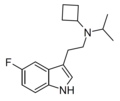 |
5-Fluoro-iPcBT | artificial | 5-F | CH(CH3)2 | CH(CH2)3 | 5-fluoro-N-isopropyl-N-cyclobutyltryptamine | |
 |
5-Fluoro-DiPT | artificial | 5-F | CH(CH3)2 | CH(CH3)2 | 5-fluoro-N,N-diisoproptryptamine | |
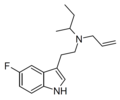 |
5-Fluoro-sBALT | artificial | 5-F | CH(CH3)CH2CH3 | CH2CH=CH2 | 5-fluoro-N-sec-butyl-N-allyltryptamine | |
 |
5-Fluoro-M1MALT | artificial | 5-F | CH3 | CH(CH3)CH=CH2 | 5-fluoro-N-methyl-N-(1-methylallyl)tryptamine | |
 |
5-Chloro-DMT | artificial | 5-Cl | CH3 | CH3 | 5-chloro-N,N-dimethyltryptamine | 22120-32-7 |
 |
5-Iodo-DMT | artificial | 5-I | CH3 | CH3 | 5-iodo-N,N-dimethyltryptamine | 22120-38-3 |
 |
5-TFM-DMT | artificial | 5-CF3 | CH3 | CH3 | 5-(trifluoromethyl)-N,N-dimethyltryptamine | 2418713-32-1 |
 |
5-TFMO-DMT[52] | artificial | 5-OCF3 | CH3 | CH3 | 5-(trifluoromethoxy)-N,N-dimethyltryptamine | |
 |
5-Nitro-DMT[53] | artificial | 5-NO2 | CH3 | CH3 | 5-nitro-N,N-dimethyltryptamine | 69937-13-9 |
 |
5-CN-DMT | artificial | 5-C≡N | CH3 | CH3 | 5-cyano-N,N-dimethyltryptamine | 17380-42-6 |
 |
5-CN-DPT | artificial | 5-C≡N | CH2CH2CH3 | CH2CH2CH3 | 5-cyano-N,N-dipropyltryptamine | 74885-19-1 |
 |
Almotriptan | artificial | 5-(CH2SO2N(CH2)4) | CH3 | CH3 | N,N-dimethyl-2- [5-(pyrrolidin-1-ylsulfonylmethyl)- 1H-indol-3-yl]-ethanamine | 154323-57-6 |
 |
Rizatriptan | artificial | 5-(CH2(N3(CH)2)) | CH3 | CH3 | N,N-dimethyl-2-[5-(1H-1,2,4-triazol-1-ylmethyl)-1H-indol-3-yl]ethanamine | 145202-66-0 |
 |
Sumatriptan | artificial | 5-(CH2SO2NHCH3) | CH3 | CH3 | 1-[3-(2-Dimethylaminoethyl)-1H-indol-5-yl]-N-methyl-methanesulfonamide | 103628-46-2 |
 |
Zolmitriptan | artificial | 5-(CHNHC=OOCH2) | CH3 | CH3 | 5-( 4-(S)-1,3-oxazolidin-2-one)-N,N-dimethyltryptamine | 139264-17-8 |
 |
6-Fluoro-DMT | artificial | 6-F | CH3 | CH3 | 6-fluoro-N,N-dimethyltryptamine | 1511-31-5 |
 |
6-Fluoro-DET[54] | artificial | 6-F | CH2CH3 | CH2CH3 | 6-fluoro-N,N-diethyltryptamine | 2836-69-3 |
 |
6-Chloro-DMT | artificial | 6-Cl | CH3 | CH3 | 6-chloro-N,N-dimethyltryptamine | 25390-72-1 |
 |
6-Methyl-DMT | artificial | 6-CH3 | CH3 | CH3 | 6,N,N-trimethyltryptamine | |
 |
6-Hydroxy-DMT | artificial | 6-OH | CH3 | CH3 | 6-hydroxy-N,N-dimethyltryptamine | 1476-33-1 |
 |
6-Hydroxy-DET | artificial | 6-OH | CH3 | CH3 | 6-hydroxy-N,N-diethyltryptamine | 1476-59-1 |
 |
6-Methoxy-DMT | artificial | 6-OCH3 | CH3 | CH3 | 6-methoxy-N,N-dimethyltryptamine | 2426-88-2 |
 |
7-Methyl-DMT | artificial | 7-CH3 | CH3 | CH3 | 7,N,N-trimethyltryptamine | 65882-39-5 |
 |
7-Ethyl-DMT | artificial | 7-CH2CH3 | CH3 | CH3 | 7-ethyl-N,N-dimethyltryptamine | |
 |
7-Chloro-DMT | artificial | 7-Cl | CH3 | CH3 | 7-chloro-N,N-dimethyltryptamine | |
 |
7-Bromo-DMT[55] | artificial | 7-Br | CH3 | CH3 | 7-bromo-N,N-dimethyltryptamine | 74798-68-8 |
 |
7-Hydroxy-DMT | artificial | 7-OH | CH3 | CH3 | 7-hydroxy-N,N-dimethyltryptamine | 7578-26-9 |
 |
7-Methoxy-DMT | artificial | 7-OCH3 | CH3 | CH3 | 7-methoxy-N,N-dimethyltryptamine | |
 |
7-Methoxy-MiPT | artificial | 7-OCH3 | CH3 | CH(CH3)2 | 7-methoxy-N-methyl-N-isopropyltryptamine | |
 |
1-Methylpsilocin | artificial | 1-CH3, 4-OH | CH3 | CH3 | 1-Methyl-3-[2-(N,N-dimethylamino)ethyl]-4-hydroxyindole | 1465-16-3 |
 |
1-Methyl-5-MeO-DiPT | artificial | 1-CH3, 5-OCH3 | CH(CH3)2 | CH(CH3)2 | 1-methyl-5-methoxy-N,N-diisopropyltryptamine | 1373882-10-0 |
 |
NBoc-DMT (NB-DMT) | artificial | 1-OCOC(CH3)3 | CH3 | CH3 | 1-(t-butoxycarbonyl)-N,N-dimethyltryptamine | |
 |
NB-5-MeO-MiPT | artificial | 1-OCOC(CH3)3, 5-OCH3 | CH3 | CH(CH3)2 | 1-(t-butoxycarbonyl)-5-methoxy-N-methyl-N-isopropyltryptamine | |
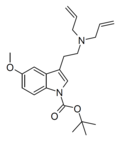 |
NB-5-MeO-DALT | artificial | 1-OCOC(CH3)3, 5-OCH3 | H2C=CH-CH2 | H2C=CH-CH2 | 1-(t-butoxycarbonyl)-5-methoxy-N,N-diallyltryptamine | |
 |
6-Fluoropsilocin | artificial | 4-OH,6-F | CH3 | CH3 | 4-hydroxy-6-fluoro-N,N-dimethyltryptamine | 312314-12-8 |
 |
6-Fluoro-5-MeO-DMT | artificial | 5-OCH3,6-F | CH3 | CH3 | 5-methoxy-6-fluoro-N,N-dimethyltryptamine | |
 |
5,6-Difluoro-EPT | artificial | 5-F, 6-F | CH2CH3 | CH2CH2CH3 | 5,6-difluoro-N-ethyl-N-propyltryptamine | |
 |
5-MeO-2-TMT | artificial | 2-CH3, 5-OCH3 | CH3 | CH3 | 2-(5-methoxy-2-methyl-H-indol-3-yl)-N,N-dimethylethanamine | 67292-68-6 |
 |
5-MeO-7-TMT | artificial | 5-OCH3, 7-CH3 | CH3 | CH3 | 5-Methoxy-7,N,N-trimethyltryptamine | 61018-77-7 |
 |
5-MeO-4-TMT | artificial | 4-CH3, 5-OCH3 | CH3 | CH3 | 5-Methoxy-4,N,N-trimethyltryptamine | |
 |
4-HO-5-MeO-DMT (psilomethoxin) | artificial | 4-OH, 5-OCH3 | CH3 | CH3 | 4-Hydroxy-5-methoxy-N,N-dimethyltryptamine | 2433-31-0 |
 |
4-F-5-MeO-DMT | artificial | 4-F, 5-OCH3 | CH3 | CH3 | 4-Fluoro-5-Methoxy-N,N-dimethyltryptamine | 312314-18-4 |
 |
5-MeO-7-F-MET | artificial | 5-OCH3, 7-F | CH3 | CH2CH3 | 5-Methoxy-7-Fluoro-N-methyl-N-ethyltryptamine | |
 |
EMDT (2-ethyl-5-MeO-DMT) | artificial | 2-CH2CH3, 5-OCH3 | CH3 | CH3 | 2-(2-ethyl-5-methoxy-1H-indol-3-yl)-N,N-dimethylethanamine | 263744-72-5 |
 |
ST-1936 (2-methyl-5-chloro-DMT) | artificial | 2-CH3, 5-Cl | CH3 | CH3 | 2-(2-methyl-5-chloro-1H-indol-3-yl)-N,N-dimethylethanamine | 1210-81-7 |
 |
O-4310 (1-isopropyl-6-fluoropsilocin) | artificial | 1-CH(CH3)2, 4-OH, 6-F | CH3 | CH3 | 3-[2-(dimethylamino)ethyl]-6-fluoro-1-isopropyl-1H-indol-4-ol | 885671-63-6 |
 |
CP-132,484 (4,5-DHP-1-Me-T) | artificial | 1-methyl-4,5-(OCH2CH2CH2) | H | H | 1-(2-aminoethyl)-3-methyl-8,9-dihydropyrano(3,2-e)indole | 143508-76-3 |
 |
4,5-DHP-DMT | artificial | 4,5-(OCH2CH2CH2) | CH3 | CH3 | 1-(2-dimethylaminoethyl)-8,9-dihydropyrano[3,2-e]indole | 135360-97-3 |
 |
4,5-DHF-DMT (P-3) | artificial[56] | 4,5-(CH2CH2O) | CH3 | CH3 | 2-(3,6-dihydro-2H-furo[2,3-e]indol-8-yl)-N,N-dimethylethan-1-amine | |
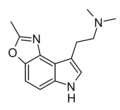 |
4,5-Methylbenzoxazole-DMT (P-131) | artificial | 4,5-(OC(CH3)=N) | CH3 | CH3 | N,N-dimethyl-2-(2-methyl-6H-[1,3]oxazolo[4,5-e]indol-8-yl)ethan-1-amine | |
 |
4,5-MDO-DMT | artificial | 4,5-(OCH2O) | CH3 | CH3 | 2-(2H,6H-[1,3]Dioxolo[4,5-e]indol-8-yl)-N,N-dimethylethan-1-amine | 81249-30-1 |
 |
4,5-MDO-DiPT | artificial | 4,5-(OCH2O) | CH(CH3)2 | CH(CH3)2 | N-[2-(2H,6H-[1,3]Dioxolo[4,5-e]indol-8-yl)ethyl]-N-(propan-2-yl)propan-2-amine | 82173-82-8 |
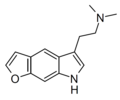 |
5,6-FUR-DMT (P-4) | artificial | 5,6-(CH=CHO) | CH3 | CH3 | 2-(7H-furo[3,2-f]indol-5-yl)-N,N-dimethylethan-1-amine | |
 |
5,6-MDO-DMT | artificial | 5,6-(OCH2O) | CH3 | CH3 | 2-(2H,5H-[1,3]Dioxolo[4,5-f]indol-7-yl)-N,N-dimethylethan-1-amine | |
 |
5,6-MDO-MiPT | artificial | 5,6-(OCH2O) | CH3 | CH(CH3)2 | N-[2-(2H,5H-[1,3]Dioxolo[4,5-f]indol-7-yl)ethyl]-N-methylpropan-2-amine | |
 |
5,6-MDO-DiPT | artificial | 5,6-(OCH2O) | CH(CH3)2 | CH(CH3)2 | N-[2-(2H,5H-[1,3]Dioxolo[4,5-f]indol-7-yl)ethyl]-N-(propan-2-yl)propan-2-amine | |
List of substituted α-alkyltryptamines
[edit]α-Alkyltryptamines are a group of substituted tryptamines which possess an alkyl group, such as a methyl or ethyl group, attached at the alpha carbon, and in most cases no substitution on the amine nitrogen.[57][58][59] α-Alkylation of tryptamine makes it much more metabolically stable and resistant to degradation by monoamine oxidase, resulting in increased potency and greatly lengthened half-life.[59] This is analogous to α-methylation of phenethylamine into amphetamine.[59]
Many α-alkyltryptamines are drugs, acting as monoamine releasing agents, non-selective serotonin receptor agonists, and/or monoamine oxidase inhibitors,[60][61][62][63] and produce psychostimulant, entactogen, and/or psychedelic effects.[57][58][59] The most well-known of these agents are α-methyltryptamine (αMT) and α-ethyltryptamine (αET), both of which were used clinically as antidepressants for a brief period of time in the past and are abused as recreational drugs.[58][59] In accordance with its action as a dual releasing agent of serotonin and dopamine, αET has been found to produce serotonergic neurotoxicity similarly to amphetamines like MDMA and PCA, and the same is also likely to hold true for other serotonin and dopamine-releasing α-alkyltryptamines such as αMT, 5-MeO-αMT, and various others.[64]
| Structure | Name | Chemical name | CAS # |
|---|---|---|---|

|
Tryptophan | (2S)-2-amino-3-(1H-indol-3-yl)propanoic acid | 73-22-3 |

|
5-Hydroxytryptophan (5-HTP) | 2-amino-3-(5-hydroxy-1H-indol-3-yl)propanoic acid | 4350-09-8 |

|
αMT (AMT; Indopan) | 1-(1H-Indol-3-yl)propan-2-amine | 299-26-3 |

|
4-HO-αMT | 3-(2-aminopropyl)-1H-indol-4-ol | 15066-09-8 |

|
4-Methyl-αMT | 1-methyl-2-(4-methyl-1H-indol-3-yl)-ethylamine | 3569-29-7 |

|
5-Fluoro-αMT | 1-(5-fluoro-1H-indol-3-yl)propan-2-amine | 712-08-3 |

|
5-Chloro-αMT | 1-(5-Chloro-1H-indol-3-yl)propan-2-amine | 712-07-2 |

|
5-HO-αMT (αMS/α-methyl-5-HT) | 3-(2-aminopropyl)-1H-indol-5-ol | 304-52-9 |

|
5-MeO-αMT | 1-(5-methoxy-1H-indol-3-yl)propan-2-amine | 1137-04-8 |

|
5-Ethoxy-αMT | 1-(5-ethoxy-1H-indol-3-yl)propan-2-amine | 101832-83-1 |
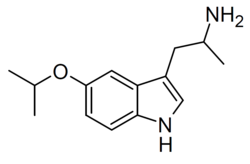
|
5-Isopropoxy-αMT | 1-{5-[(propan-2-yl)oxy]-1H-indol-3-yl}propan-2-amine | |

|
5-Allyloxy-αMT | 1-{5-[(prop-2-en-1-yl)oxy]-1H-indol-3-yl}propan-2-amine | |

|
BW-723C86 | 1-[5-(2-Thienylmethoxy)-1H-indol-3-yl]-2-propanamine | 160521-72-2 |

|
6-Fluoro-αMT | 1-(6-fluoro-1H-indol-3-yl)propan-2-amine | 712-11-8 |

|
7-Chloro-AMT | 1-(7-chloro-1H-indol-3-yl)propan-2-amine | 711-99-9 |

|
AL-37350A (4,5-DHP-αMT) | (S)-(+)-1-(2-Aminopropyl)-8,9-dihydropyrano[3,2-e]indole | 362603-40-5 |

|
Compound 5 [65] | 1-(3H-benzo[e]indol-1-yl)propan-2-amine | |

|
αET | 1-(1H-indol-3-yl)butan-2-amine | 2235-90-7 |

|
4-Methyl-αET | 1-(4-Methyl-1H-indol-3-yl)butan-2-amine | 28289-30-7 |

|
4-HO-αET | 1-(4-hydroxy-1H-indol-3-yl)butan-2-amine | 28289-28-3 |

|
5-Fluoro-αET | 1-(5-fluoro-1H-indol-3-yl)butan-2-amine | 1380137-98-3 |

|
5-Methyl-αET | 1-(5-methyl-1H-indol-3-yl)butan-2-amine | 1380148-21-9 |

|
5-MeO-αET | 1-(5-methoxy-1H-indol-3-yl)butan-2-amine | 4765-10-0 |

|
7-Methyl-αET | 1-(7-methyl-1H-indol-3-yl)butan-2-amine | 13712-80-6 |

|
α,N-DMT (SK&F-7024, Ro 3-1715; N-methyl-AMT) | 1-(1H-indol-3-yl)-N-methylpropan-2-amine | 299-24-1 |

|
N,N-Dimethyl-αMT (α,N,N-TMT) | (2-(1H-Indol-3-yl)-1-methyl-ethyl)dimethylamine | 4761-32-4 |

|
N-Hydroxy-AMT (N-HO-AMT) | N-[1-(1H-indol-3-yl)propan-2-yl]hydroxylamine | 63-33-2 |

|
N-Methyl-5-MeO-αMT (α,N,O-TMS/α,N,O-trimethyl-5-HT) | [1-(5-methoxy-1H-indol-3-yl)propan-2-yl](methyl)amine | 4822-13-3 |

|
N,N-Dimethyl-5-MeO-αMT (5-MeO-α,N,N-TMT) | (2-(5-methoxy-1H-Indol-3-yl)-1-methyl-ethyl)dimethylamine | 101831-90-7 |

|
α-Propyltryptamine (APT; αPT; α-PT) | 1-(1H-indol-3-yl)pentan-2-amine | |

|
Indolylpropylaminopentane (IPAP; α,N-DPT) | 1-(1H-indol-3-yl)-N-propylpentan-2-amine | |

|
α-Methyl-DiPT | (2-(1H-Indol-3-yl)-1-methyl-ethyl)diisopropylamine | |

|
MPMI[66] | 3-[(1-methylpyrrolidin-2-yl)methyl]-1H-indole | 143321-54-4 |

|
Lucigenol (4-HO-MPMI) | (R)-3-(N-methylpyrrolidin-2-ylmethyl)-4-hydoxyindole | 250672-65-2 |

|
5-MeO-MPMI (CP-108509) | 5-Methoxy-3-{[(2R)-1-methylpyrrolidin-2-yl]methyl}-1H-indole | 143321-57-7 |

|
5F-MPMI[67] | (R)-5-fluoro-3-[(1-methylpyrrolidin-2-yl)methyl]-1H-indole | |

|
5-Br-MPMI | 5-bromo-3-[(1-methylpyrrolidin-2-yl)methyl]-1H-indole | 143322-57-0 |

|
Eletriptan | 3-{[(2R)-1-methylpyrrolidin-2-yl]methyl}-5-[2-(benzenesulfonyl)ethyl]-1H-indole | 143322-58-1 |

|
Z5247692566[42][68] | 4-[(3,3-dimethyloxolan-2-yl)methyl]-3-[(1H-indol-3-yl)methyl]morpholine | |

|
BK-NM-AMT (α,N-dimethyl-β-ketotryptamine)[69][70][71] | 1-(1H-indol-3-yl)-2-(methylamino)propan-1-one | |

|
BK-5F-NM-AMT (5-fluoro-α,N-dimethyl-β-ketotryptamine)[72][73][74][71] | 1-(5-fluoro-1H-indol-3-yl)-2-(methylamino)propan-1-one | |

|
BK-5Cl-NM-AMT (5-chloro-α,N-dimethyl-β-ketotryptamine)[74][75][76] | 1-(5-chloro-1H-indol-3-yl)-2-(methylamino)propan-1-one | |

|
BK-5Br-NM-AMT (5-bromo-α,N-dimethyl-β-ketotryptamine)[74][77][78] | 1-(5-bromo-1H-indol-3-yl)-2-(methylamino)propan-1-one |
List of substituted β-ketotryptamines
[edit]A number of β-ketotryptamines (beta-ketotryptamines) are known.[69][71][74] These compounds are α-alkyl-β-ketotryptamines and are analogous to the cathinones (β-ketoamphetamines) of the related phenethylamine family. Known β-ketotryptamines include BK-NM-AMT, BK-5F-NM-AMT, BK-5Cl-NM-AMT, and BK-5Br-NM-AMT.[69][71][74] They act as monoamine releasing agents.[69][71][74]
Cyclized tryptamines
[edit]Examples of cyclized tryptamines include:
- β-Carbolines such as harmala alkaloids like harmaline
- Ibogalogs (hexahydroazepinoindoles) such as ibogainalog, tabernanthalog, PNU-22394, and PHA-57378
- Iboga alkaloids like ibogaine, noribogaine, ibogamine, and tabernanthine
- Ergolines and lysergamides such as lysergic acid diethylamide (LSD) and ergot alkaloids like ergine (lysergic acid amide; LSA)
- Partial ergolines and lysergamides like RU-27849, FHATHBIN, NDTDI, and CT-5252
- Mitragyna alkaloids such as mitragynine
- Yohimbans such as Rauvolfia and Corynanthe alkaloids like yohimbine and rauwolscine
- Pertines (phenylpiperazinylethylindoles) like alpertine, milipertine, oxypertine, and solypertine
- Imidazolylindoles like AGH-107, AGH-192, and AH-494
- Morpholinylethylindoles like mor-T and 5-MeO-mor-T
- Piperidinylethylindoles like pip-T and 5-MeO-pip-T
- Pyrrolidinylethylindoles like pyr-T, 4-HO-pyr-T, 5-MeO-pyr-T, and 4-F-5-MeO-pyr-T
- Pyrrolidinylmethylindoles like MPMI, 4-HO-MPMI (lucigenol), 5F-MPMI, 5-MeO-MPMI, CP-135807, and eletriptan
- Tetrahydropyridinylindoles like RS134-49 (4-Me-THPI), RU-28253 (5-MeO-THPI), and NEtPhOH-THPI
- Tetrahydrocarbazolamines like ciclindole, flucindole, frovatriptan, LY-344864, and ramatroban
- Tetrahydropyrroloquinolines like bufothionine, O-methylnordehydrobufotenine, and dehydrobufotenine
- Others like 5-MeO-IsoqT, barettin, cyclic 3-hydroxymelatonin, and metralindole
Other closely related cyclized tryptamine-like compounds include the following:
- Piperidinylindoles like SN-22, BRL-54443, naratriptan, LY-334370, and sertindole
- Tetrahydropyridinylindoles like RU-24969, EMD-386088, and LY-367,265
- Tetrahydropyridinylindazoles like VU6067416
- Tetrahydropyridinylpyrrolopyridines like (R)-69, (R)-70, and CP-94253
- Pyridopyrroloquinoxalines (tetracyclic γ-carbolines) like lumateperone, IHCH-7113, IHCH-7086, and ITI-1549
Related compounds
[edit]A number of related compounds are known, with a similar structure but having the indole core flipped (isotryptamines) and/or replaced with related cores such as indene, indoline, indazole, indolizine, benzothiophene, or benzofuran. Like tryptamines, these related compounds are primarily active as agonists at the 5-HT2 family of serotonin receptors, with applications in the treatment of glaucoma, cluster headaches, or as anorectics.
| Structure | Name | Chemical name | CAS # |
|---|---|---|---|

|
C-DMT[79] | 2-(3H-inden-1-yl)-N,N-dimethylethanamine | |

|
Dimemebfe (5-MeO-BFE) | 2-(5-Methoxy-1-benzofuran-3-yl)-N,N-dimethylethanamine | 140853-58-3 |

|
5-MeO-DiBF | N-[2-(5-Methoxy-1-benzofuran-3-yl)ethyl]-N-(propan-2-yl)propan-2-amine | |

|
3-APB | 3-(2-aminopropyl)benzofuran | 105909-13-5 |

|
3-APBT (SKF-6678) | 1-(1-benzothiophen-3-yl)propan-2-amine | 1201-27-0 |

|
Mebfap (5-MeO-3-APB) | 3-(2-aminopropyl)-5-methoxybenzofuran | 140853-59-4 |

|
Isotryptamine (isoT) | 2-indol-1-ylethanamine | 13708-58-2 |

|
isoAMT | 1-indol-1-ylpropan-2-amine | 1227465-67-9 |

|
(S)-5,6-Difluoro-isoAMT [80] | (S)-1-(5,6-difluoroindol-1-yl)propan-2-amine | |

|
Ro60-0175 ((S)-5-F-6-Cl-isoAMT) | (S)-(6-chloro-5-fluoro-1H-indol-1-yl)propan-2-amine | 169675-09-6 |

|
isoDMT | 2-indol-1-yl-N,N-dimethylethanamine | 87482-09-5 |

|
5-MeO-isoDMT | 2-(5-methoxyindol-1-yl)-N,N-dimethylethanamine | 244122-80-3 |

|
6-MeO-isoDMT | 2-(6-methoxyindol-1-yl)-N,N-dimethylethanamine | 87482-11-9 |

|
Zalsupindole (DLX-001; AAZ-A-154; (R)-5-MeO-α-Me-isoDMT) | (2R)-1-(5-methoxy-1H-indol-1-yl)-N,N-dimethylpropan-2-amine | 2481740-94-5 |

|
2ZEDMA | 2-indolizin-1-yl-N,N-dimethylethanamine | |

|
1ZP2MA | 1-indolizin-1-yl-N-methylpropan-2-amine | |

|
1Z2MAP1O | 1-indolizin-3-yl-2-(methylamino)propan-1-one | 2110204-31-2 |

|
Example 16 [81][82] | 1-(7-methoxyimidazo[1,5-a]pyridin-3-yl)-N,N-dimethylpropan-2-amine | |

|
Example 1 [83] | 1-(3-methyl-8,9-dihydropyrano[2,3-g]indol-1(7H)-yl)propan-2-amine | |

|
VER-3323 | (2S)-1-(6-bromo-2,3-dihydroindol-1-yl)propan-2-amine | 259857-99-3 |

|
AL-34662 (indazole-5-HO-AMT) | 1-((S)-2-Aminopropyl)-1H-indazol-6-ol | 210580-75-9 |

|
O-Methyl-AL-34662 (indazole-5-MeO-AMT) | 1-((S)-6-methoxy-2-aminopropyl)-1H-indazole | 210580-60-2 |

|
7-Methyl-AL-34662 | 1-((S)-2-Aminopropyl)-7-methyl-1H-indazol-6-ol | 874668-67-4 |

|
7-Chloro-AL-34662 | 1-((S)-2-Aminopropyl)-7-chloro-1H-indazol-6-ol | 874881-86-4 |

|
AL-38022A | (S)-2-(8,9-dihydro-7H-pyrano[2,3-g]indazol-1-yl)-1-methylethylamine | 478132-11-5 |

|
Example 9 [84] | (S)-α-methyl-pyrano[2,3-g]indazole-1(7H)-ethanamine | 478132-12-6 |

|
Example 3 [85] | (S)-7,8-dihydro-α-methyl-1H-[1,4]dioxino[2,3-g]indazole-1-ethanamine | 890087-75-9 |

|
Example 1 [86] | (S)-8,9-dihydro-α,9-dimethylpyrazolo[3,4-f][1,4]benzoxazine-1(7H)-ethanamine | 1373917-69-1 |

|
YM-348 | (2S)-1-(7-ethyl-1H-furo[2,3-g]indazol-1-yl)propan-2-amine | 372163-84-3 |

|
2-Desethyl-YM-348 [87] | (2S)-1-(1H-furo[2,3-g]indazol-1-yl)propan-2-amine | 748116-94-1 |
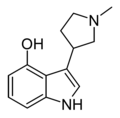
|
I-32 [88] | 3-(1-methylpyrrolidin-3-yl)-1H-indol-4-ol | |

|
2-Azapsilocin (Psilocin indazole analogue, P-6)[89] | 3-[2-(dimethylamino)ethyl]-1H-indazol-4-ol | |

|
4-Aza-5-MeO-DPT (P-11) | N-[2-(5-methoxy-1H-pyrrolo[3,2-b]pyridin-3-yl)ethyl]-N-propylpropan-1-amine | |

|
5-Aza-4-MeO-DiPT (P-36) | N-[2-(4-methoxy-1H-pyrrolo[3,2-c]pyridin-3-yl)ethyl]-N-(propan-2-yl)propan-2-amine | |

|
7-Aza-5-MeO-DiPT (P-19) | N-[2-(5-methoxy-1H-pyrrolo[2,3-b]pyridin-3-yl)ethyl]-N-(propan-2-yl)propan-2-amine | |

|
RS134-49 (4-Me-THPI) | 4-methyl-3-(1,2,3,6-tetrahydropyridin-5-yl)-1H-indole | 2945139-94-4 |

|
RU-28253 (5-MeO-THPI) | 5-methoxy-3-(1,2,3,6-tetrahydropyridin-5-yl)-1H-indole | |

|
NEtPhOH-THPI (compound 24c) | 3-(1-(2-hydroxyphenylethyl)-1,2,3,6-tetrahydropyridin-5-yl)-1H-indole | |
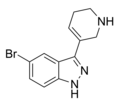
|
VU6067416[90] | 3-(1,2,5,6-tetrahydropyridin-3-yl)-5-bromo-1H-indazole | 3027515-24-5 |

|
(R)-69 | 3-[(5R)-5-methyl-1,2,5,6-tetrahydropyridin-3-yl]-1H-pyrrolo[2,3-b]pyridine | 2765652-48-8 |

|
SN-22 | 3-(1-methylpiperidin-4-yl)-1H-indole | 17403-07-5 |

|
RU-24,969 | 5-methoxy-3-(1,2,5,6-tetrahydro-4-pyridinyl)-1H-indole | 107008-28-6 |

|
EMD-386088 | 5-chloro-2-methyl-3-(1,2,3,6-tetrahydro-4-pyridinyl)-1H-indole | 54635-62-0 |
Overview table
[edit]See also
[edit]- Substituted β-carboline
- Ibogalog
- Iboga alkaloid
- Lysergamide
- TiHKAL
- List of miscellaneous 5-HT2A receptor agonists
- Substituted isotryptamine
- Indazolylethylamine
- Indolizinylethylamine
- Tetrahydropyridinylpyrrolopyridine
- Substituted 2-aminoindane
- Substituted amphetamine
- Substituted benzofuran
- Substituted cathinone
- Substituted methylenedioxyphenethylamine
- Substituted phenethylamine
- 2C, DOx, 25-NB
References
[edit]- ^ Chemistry, University of; Prague, Technology. "Concentrations of psychoactive compounds in mushrooms found to be extremely variable". phys.org. Retrieved 2022-12-26.
- ^ a b c d e f g h i Shulgin, Alexander; Shulgin, Ann (September 1997). TiHKAL: The Continuation. Berkeley, California: Transform Press. ISBN 0-9630096-9-9. OCLC 38503252.
- ^ a b c d e f g Jacob P, Shulgin AT (1994). "Structure-activity relationships of the classic hallucinogens and their analogs" (PDF). NIDA Res Monogr. 146: 74–91. PMID 8742795. Archived from the original (PDF) on August 5, 2023.
- ^ a b c d e f g Shulgin AT (2003). "Basic Pharmacology and Effects". In Laing RR (ed.). Hallucinogens: A Forensic Drug Handbook. Forensic Drug Handbook Series. Elsevier Science. pp. 67–137. ISBN 978-0-12-433951-4.
- ^ Shulgin AT (1982). "Chemistry of Psychotomimetics". In Hoffmeister F, Stille G (eds.). Psychotropic Agents, Part III: Alcohol and Psychotomimetics, Psychotropic Effects of Central Acting Drugs. Handbook of Experimental Pharmacology. Vol. 55 / 3. Berlin: Springer Berlin Heidelberg. pp. 3–29. doi:10.1007/978-3-642-67770-0_1. ISBN 978-3-642-67772-4. OCLC 8130916.
- ^ Alexander T. Shulgin (1980). "Hallucinogens". In Burger A, Wolf ME (eds.). Burger's Medicinal Chemistry. Vol. 3 (4 ed.). New York: Wiley. pp. 1109–1137. ISBN 978-0-471-01572-7. OCLC 219960627.
- ^ a b c d e Luethi D, Liechti ME (October 2018). "Monoamine Transporter and Receptor Interaction Profiles in Vitro Predict Reported Human Doses of Novel Psychoactive Stimulants and Psychedelics". Int J Neuropsychopharmacol. 21 (10): 926–931. doi:10.1093/ijnp/pyy047. PMC 6165951. PMID 29850881.
- ^ a b c d e Halberstadt, Adam L.; Chatha, Muhammad; Klein, Adam K.; Wallach, Jason; Brandt, Simon D. (May 2020). "Correlation between the potency of hallucinogens in the mouse head-twitch response assay and their behavioral and subjective effects in other species" (PDF). Neuropharmacology. 167 107933. doi:10.1016/j.neuropharm.2019.107933. PMC 9191653. PMID 31917152. Archived from the original (PDF) on 26 March 2025.
Table 4 Human potency data for selected hallucinogens. [...]
- ^ a b c d e Ballentine, Galen; Friedman, Samuel Freesun; Bzdok, Danilo (March 2022). "Trips and neurotransmitters: Discovering principled patterns across 6850 hallucinogenic experiences". Sci Adv. 8 (11) eabl6989. Bibcode:2022SciA....8L6989B. doi:10.1126/sciadv.abl6989. PMC 8926331. PMID 35294242.
- ^ Mallaroni P, Mason NL, Vinckenbosch FR, Ramaekers JG (June 2022). "The use patterns of novel psychedelics: experiential fingerprints of substituted phenethylamines, tryptamines and lysergamides". Psychopharmacology (Berl). 239 (6): 1783–1796. doi:10.1007/s00213-022-06142-4. PMC 9166850. PMID 35487983.
- ^ a b c d e f g McKenna DJ, Towers GH (1984). "Biochemistry and pharmacology of tryptamines and beta-carbolines. A minireview". J Psychoactive Drugs. 16 (4): 347–358. doi:10.1080/02791072.1984.10472305. PMID 6394730.
- ^ Nen (4 December 2011). Entheogenic effects of NMT from Acacia. Entheogenesis Australis (EGA) Conference, Victoria, Australia, 2–5 December 2011 (PDF). Archived from the original on 5 April 2025. Retrieved 15 April 2025.
{{cite conference}}: CS1 maint: bot: original URL status unknown (link) - ^ Nen (13 July 2013). NMT: A Spatial Hallucinogen With Therapeutic Applications. Breaking Convention: The Second Multidisciplinary Conference on Psychedelic Consciousness, University of Greenwich, London, 12–14 July 2013.
- ^ a b Liechti ME, Holze F (2022). "Dosing Psychedelics and MDMA". Disruptive Psychopharmacology. Curr Top Behav Neurosci. Vol. 56. pp. 3–21. doi:10.1007/7854_2021_270. ISBN 978-3-031-12183-8. PMID 34734392.
- ^ a b c Holze F, Singh N, Liechti ME, D'Souza DC (May 2024). "Serotonergic Psychedelics: A Comparative Review of Efficacy, Safety, Pharmacokinetics, and Binding Profile". Biol Psychiatry Cogn Neurosci Neuroimaging. 9 (5): 472–489. doi:10.1016/j.bpsc.2024.01.007. PMID 38301886.
- ^ Dos Santos RG, Hallak JE (November 2024). "Ayahuasca: pharmacology, safety, and therapeutic effects". CNS Spectr. 30 (1): e2. doi:10.1017/S109285292400213X. PMID 39564645.
DMT has been found to be inactive orally in doses as high as 1 g, but it has been found to be psychoactive after intramuscular administration (0.25-2.00 mg/kg), when inhaled as vaporized free-base (0.2-0.7 mg/kg), and after intravenous administration (0.2-0.4 mg/kg).8–10 [...] In the case of ayahuasca, since pure DMT is not orally psychoactive (doses up to 1 g are inactive in humans51) due to peripheral (gastrointestinal and hepatic) metabolization by MAO-A, [...]
- ^ Barker SA (June 2022). "Administration of N,N-dimethyltryptamine (DMT) in psychedelic therapeutics and research and the study of endogenous DMT". Psychopharmacology (Berl). 239 (6): 1749–1763. doi:10.1007/s00213-022-06065-0. PMC 8782705. PMID 35064294.
Doses for vaporized or inhaled free-base DMT are typically 40–50 mg, although larger doses have been reported (100 mg; Shulgin and Shulgin 1997). Pallavicini et al. (2021) have reported that vaporization of approximately 40 mg of DMT, administered in a natural setting, produced potential electroencephalographic markers of mystical-type experiences in 35 volunteers. The onset of effects for inhaled DMT is rapid, similar to that of IV administration, but lasts less than 30 min (Riba et al. 2015; Davis et al. 2020). [...] For administration of pharmahuasca, 50 mg DMT:100 mg harmaline is usually the recommended dosage. However, combinations of 50 mg harmaline:50 mg harmine and 50 mg DMT have been tested with success. The harmalas and DMT are typically put into separate gelatin capsules, with the harmaline/harmine being taken first and the DMT being taken 15 to 20 min later. The use of moclobemide, a reversible inhibitor of MAO-A, has also been reported in DMT "pharmahuasca" studies (Kaasik et al. 2020; Ruffell et al. 2020).
- ^ Egger K, Aicher HD, Cumming P, Scheidegger M (September 2024). "Neurobiological research on N,N-dimethyltryptamine (DMT) and its potentiation by monoamine oxidase (MAO) inhibition: from ayahuasca to synthetic combinations of DMT and MAO inhibitors". Cell Mol Life Sci. 81 (1) 395. doi:10.1007/s00018-024-05353-6. PMC 11387584. PMID 39254764.
Recent studies tested i.v. DMT with different administration regimens. Such protocols entailed 0–19.2 mg bolus 0.5–0.8 mg/min constant infusion of DMT freebase (as hemifumarate) for up to 90 min (Basel) [7], 11.2 mg bolus 1.2 mg/min infusion of DMT freebase (as fumarate) for up to 30 min (London) [8], and constant infusion totaling 13.4 mg DMT freebase (as fumarate) over 10 min (London) [110]). [...] The various β-carbolines in B. caapi, especially harmine and harmaline, enable the attainment of sufficient plasma DMT concentrations to evoke psychedelic effects lasting 4–6 h [5, 61].
- ^ a b Ott J (1999). "Pharmahuasca: human pharmacology of oral DMT plus harmine". J Psychoactive Drugs. 31 (2): 171–177. doi:10.1080/02791072.1999.10471741. PMID 10438001.
Since the β-carbolines per se could not explain the legendary psychoptic (visionary) activity of the jungle ambrosia, this had to be due to its DMT content, which amounted to an average of 29 mg/dose in the 16 potions analyzed (range: 25-36 mg/dose). [...] TABLE 1 Human Pharmacology of Psychoptic Tryptamines [...]
- ^ Brimblecombe RW, Pinder RM (1975). "Indolealkylamines and Related Compounds". Hallucinogenic Agents. Bristol: Wright-Scientechnica. pp. 98–144. ISBN 978-0-85608-011-1. OCLC 2176880. OL 4850660M.
Other N,N-dialkyltryptamines produce similar effects to DMT in man, though their persistence is somewhat greater, with hallucinations lasting for up to 3 hours (Szara and Hearst, 1962). These include the N,N-diethyl (DET, 4.8), N,N-dipropyl (4.9), and N,N-diallyl (4.10) compounds, none of which are found in nature.
- ^ a b Szara, Stephen; Hearst, Eliot (1962). "The 6-Hydroxylation of Tryptamines Derivatives: A Way of Producing Psychoactive Metabolites". Annals of the New York Academy of Sciences. 96 (1): 134–141. Bibcode:1962NYASA..96..134S. doi:10.1111/j.1749-6632.1962.tb50108.x. ISSN 0077-8923.
This correlation between metabolic transformation rates and psychological effect is suggestive. It strengthens our notion that metabolically formed 6-HDET most likely plays a role in producing the psychological effects. A more stringent test would be to give the metabolite directly to the same subjects, as was done in the animal experiments. Unfortunately we did not have enough synthetic 6-HDET to do extensive human studies, so the senior author tried it out himself. Both 1 and 2 mg. of 6-HDET had no noticeable effect. At 5 mg. there was only a very faint short-lasting perceptual disturbance. Then, on the fourth attempt, 10 mg. of 6-HDET was administered. No obvious effect on behavior occurred in the first hour, but then typical psychotomimetic disturbances began to appear. For the next 2 or 3 hours hallucinogenic effects were observed that were very similar to the effect of 60 mg. of DET. These experiments lead us to believe that 6-HDET in man is 5 to 6 times more active psychotropically than DET, but more extended studies will be necessary to establish the exact form of the relationship.
- ^ Nichols DE, Glennon RA (1984). "Medicinal Chemistry and Structure-Activity Relationships of Hallucinogens". In Jacobs BL (ed.). Hallucinogens: Neurochemical, Behavioral, and Clinical Perspectives. New York: Raven Press. pp. 95–142. ISBN 978-0-89004-990-7. OCLC 10324237.
Szara and co-workers (221,223,225) noted psychotomimetic activity for N,N-diethyltryptamine (DET; 38) at a dose of 1 mg/kg. [...] N,N-Dipropyltryptamine (DPT; 39) is also hallucinogenic in man at 1 mg/kg (222). [...] Branching of the propyl groups results in N,N-diisopropyltryptamine (DIPT; 40), which is orally active at 20 to 50 mg (202). N,N-Dibutyltryptamine (DBT; 41) and N,N-dihexyltryptamine (DHT; 42) have been examined only briefly. At 1 mg/kg, DBT produced only slight perceptual, emotional, and thinking disturbances in man, while DHT at the same dose was completely inactive (222).
- ^ Szára, S. (1961). "104 Correlation between Metabolism and Behavioural Action of Psychotropic Tryptamine Derivatives". Biochemical Pharmacology. 8 (1): 32. doi:10.1016/0006-2952(61)90278-7.
N,N-dimethyltryptamine and its N,N-diethyl and N,N-dipropyl homologues produce autonomic symptoms, perceptual, emotional, and thinking disturbances in man (in doses of 1 mg/kg) similar to LSD25 or mescalin but for a much shorter period of time. The corresponding dibutyl derivative causes only very slight symptoms while the dihexyl compound is completely inactive in the same dose.
- ^ Malaca S, Lo Faro AF, Tamborra A, Pichini S, Busardò FP, Huestis MA (December 2020). "Toxicology and Analysis of Psychoactive Tryptamines". International Journal of Molecular Sciences. 21 (23): 9279. doi:10.3390/ijms21239279. PMC 7730282. PMID 33291798.
4-OH-DPT is the 4-hydroxylated DPT derivative first synthesized by Shulgin et al. [82]. 4-OH-DPT is a light beige or white powder [54] that acts as a 5-HT2A partial agonist. 4-OH-DPT also shares structural similarity with psilocin [83]. Effects are dose dependent, with onset at 15–45 min and duration of 5–8 h. According to user reports, synthetic 4-OH-DPT produces visual effects and hallucinatory states [84].
- ^ Ludbrook G, Bryson N, Taylor B, Hocevar-Trnka J, Johnson MW, Hirman J, Morrish G, Alexander R, Pollack M (2025). "Safety, Tolerability, Pharmacokinetics, and Pharmacodynamics of Subcutaneous RE104: A Double-Blind, Randomized, Single Ascending Dose Placebo-Controlled Study". J Clin Psychopharmacol. 45 (5): 441–453. doi:10.1097/JCP.0000000000002047. PMC 12379775. PMID 40685873.
- ^ Ott J (2001). "Pharmañopo-psychonautics: human intranasal, sublingual, intrarectal, pulmonary and oral pharmacology of bufotenine". Journal of Psychoactive Drugs. 33 (3): 273–281. doi:10.1080/02791072.2001.10400574. PMID 11718320. S2CID 5877023.
- ^ Ott J (2001). "Shamanic-Snuff Psychonautica: Pharmañopo: Bufotenine—Psychonautics". Shamanic Snuffs or Entheogenic Errhines. Entheobotanica. pp. 99–116 (105–112, 114–115). ISBN 978-1-888755-02-2. OCLC 56061312. Retrieved 24 January 2025.
- ^ Hamilton Morris (1 December 2022). "A New One-Hour Talk On 5-MeO-DMT". The Hamilton Morris Podcast. Patreon. Event occurs at 6:27–8:40, 10:15–11:13. Retrieved 21 January 2025.
[Morris:] Bufotenine is a drug that I have tried. I've tried isolated pure bufotenine and it is a psychedelic that is both pharmacologically and experientially and chemically intermediate between DMT and 5-MeO-DMT. So it has a longer duration than actually both 5-MeO-DMT and DMT. It's yet less visual than DMT but more visual than 5-MeO-DMT, so it's kind of like in-between the two. It's also very nauseating, which is the main reason that people seem not to enjoy it very much. But it is a classical psychedelic drug that produces visionary effects. And Jonathan Ott actually liked the effect of it quite a bit.
- ^ Hamilton Morris (1 September 2021). "PODCAST 28: A talk with Jonathan Ott". The Hamilton Morris Podcast (Podcast). Patreon. Event occurs at 49:20–50:36. Retrieved 20 January 2025.
[Morris:] I've used [bufotenine] a couple times, once at 50 milligrams of the freebase snorted. [...] I found it to be extremely nauseating. I found it to be qualitatively intermediate between 5-MeO-DMT and DMT in that it was more visual than my experiences with 5-MeO-DMT but less visual than my typical experiences with DMT. It had a longer duration than 5-MeO-DMT and maybe even a longer duration than DMT as well. It was about an hour. Although I don't have all that much experience snorting DMT freebase.
- ^ "Unusual Analogues: Drugs Used by Gordon Todd Skinner". thislandpress.com. This Land Press. Archived from the original on 17 April 2016. Retrieved 8 April 2016.
- ^ Hamilton Morris (29 April 2025). "POD 126: The Return of Psychedelic Selenium with Dr. Josh Hartsel". The Hamilton Morris Podcast (Podcast). Patreon. Event occurs at 1:33:53–1:35:50.
[...] [Hartsel:] The α,N,N-Dimethyl[tryptamine]. [Morris:] Oh yeah, I've made it and tried it actually. [Hartsel:] Oh you did? [Morris:] Yeah, yeah. [Hartsel:] Oh, well what did it do? [Morris:] It is active, it's an active psychedelic. It's reduced potency. I never got it to a dose where it produced particularly interesting effects. I can look up the exact dose. I think it was like... the only thing I remember is that I felt like it was making me sneeze a lot. But it was very pleasant. Nothing bad happened. But the dose just wasn't high enough. I think I took maybe 40 mg. So it was much less potent than AMT orally. The other issue of course is that it could be a prodrug of N-methyl-AMT, which is active, or AMT itself maybe. [...]
- ^ Morris H, Wallach J (26 March 2013). "Sea DMT: God Molecule or Barnacle Repellent?". Vice. Retrieved 21 October 2015.
- ^ Marek GJ, Makai-Bölöni S, Umbricht D, Christian EP, Winters J, Dvorak D, Raines S, Hughes ZA, Austin EW, Klein AK, Leong W, Krol FJ, Graaf AJV, Juachon MJ, Otto ME, Borghans LGJM, Jacobs G, Kruegel AC, Sporn J. A novel psychedelic 5-HT2A receptor agonist GM-2505: The pharmacokinetic, safety, and pharmacodynamic profile from a randomized trial healthy volunteer. J Psychopharmacol. 2025 Oct 16:2698811251378512. doi:10.1177/02698811251378512 PMID 41099491
- ^ Jain MK, Gumpper RH, Slocum ST, Schmitz GP, Madsen JS, Tummino TA, Suomivuori CM, Huang XP, Shub L, DiBerto JF, Kim K, DeLeon C, Krumm BE, Fay JF, Keiser M, Hauser AS, Dror RO, Shoichet B, Gloriam DE, Nichols DE, Roth BL (July 2025). "The polypharmacology of psychedelics reveals multiple targets for potential therapeutics" (PDF). Neuron. 113 (19): 3129–3142.e9. doi:10.1016/j.neuron.2025.06.012. PMID 40683247.
- ^ Ray TS (February 2010). "Psychedelics and the human receptorome". PLOS ONE. 5 (2) e9019. Bibcode:2010PLoSO...5.9019R. doi:10.1371/journal.pone.0009019. PMC 2814854. PMID 20126400.
- ^ a b Collins M (2011). "Some new psychoactive substances: precursor chemicals and synthesis-driven end-products". Drug Test Anal. 3 (7–8): 404–416. doi:10.1002/dta.315. PMID 21755608.
- ^ a b Appendino G, Minassi A, Taglialatela-Scafati O (July 2014). "Recreational drug discovery: natural products as lead structures for the synthesis of smart drugs". Nat Prod Rep. 31 (7): 880–904. doi:10.1039/c4np00010b. PMID 24823967.
- ^ Shaba, Reham (24 September 2020). "Development of an improved psilocybin synthesis". DIVA. Retrieved 9 November 2025.
- ^ Sherwood AM, Burkhartzmeyer EK, Williamson SE, Baumann MH, Glatfelter GC (Jan 2024). "Psychedelic-like Activity of Norpsilocin Analogues". ACS Chem Neurosci. 15 (2): 315–327. doi:10.1021/acschemneuro.3c00610. PMC 10797613. PMID 38189238.
{{cite journal}}: CS1 maint: multiple names: authors list (link) - ^ Toro-Sazo M, Brea J, Loza MI, Cimadevila M, Cassels BK (2019). "5-HT2 receptor binding, functional activity and selectivity in N-benzyltryptamines". PLOS ONE. 14 (1) e0209804. Bibcode:2019PLoSO..1409804T. doi:10.1371/journal.pone.0209804. PMC 6328172. PMID 30629611.
- ^ Jensen N. Tryptamines as Ligands and Modulators of the Serotonin 5-HT2A Receptor and the Isolation of Aeruginascin from the Hallucinogenic Mushroom Inocybe aeruginascens. PhD thesis, University of Göttingen, 2004
- ^ a b Lyu J, Kapolka N, Gumpper R, Alon A, Wang L, Jain MK, et al. (December 2023). "AlphaFold2 structures template ligand discovery". bioRxiv. doi:10.1101/2023.12.20.572662. PMC 10769324. PMID 38187536.
- ^ a b Stirn J, Berger R, Hübner H, Gmeiner P, Klein CD (2025). "Towards "unmakable" psychedelics: SAR exploration of psilocin analogs obtained by a HATU-mediated amide coupling strategy". European Journal of Medicinal Chemistry Reports. 15 100278. doi:10.1016/j.ejmcr.2025.100278.
- ^ McKay JB, Parkhurst RM, Silverstein RM, Skinner WA (October 1963). "Analogues of Psilocin and Lysergic acid diethylamide I. Chloro, Nitro, and Amino Derivatives of 3-Substituted Indoles". Canadian Journal of Chemistry. 41 (10): 2585–2590. Bibcode:1963CaJCh..41.2585M. doi:10.1139/v63-378.
- ^ Klein AK, Chatha M, Laskowski LJ, Anderson EI, Brandt SD, Chapman SJ, McCorvy JD, Halberstadt AL (April 2021). "Investigation of the Structure-Activity Relationships of Psilocybin Analogues". ACS Pharmacology & Translational Science. 4 (2): 533–542. doi:10.1021/acsptsci.0c00176. PMC 8033608. PMID 33860183.
- ^ Pham DN, Chadeayne AR, Golen JA, Manke DR (February 2021). "Psilacetin derivatives: fumarate salts of the meth-yl-ethyl, meth-yl-allyl and diallyl variants of the psilocin prodrug". Acta Crystallographica Section E. 77 (Pt 2): 101–106. Bibcode:2021AcCrE..77..101P. doi:10.1107/S2056989021000116. PMC 7869532. PMID 33614134.
- ^ WO 2023115167, Banister S, Jorgensen W, Jinlong T, "Compounds", published 29 June 2023, assigned to Psylo Pty Ltd.
- ^ WO 2021179091, Kozikowski A, Shaprio G, Tueckmantel W, McCorvy J, "3-(2-(Aminoethyl)-indol-4-ol derivatives, methods of preparation thereof, and the use as 5-HT2 receptor modulators", published 16 September 2021, assigned to Bright Minds Biosciences Inc. and The Medical College Of Wisconsin Inc.
- ^ WO 2021101926, Stamets PE, "Tryptamine Compositions for Enhancing Neurite Outgrowth.", published 2021-05-27, assigned to Stamets Paul Edward.
- ^ WO 2021168082, Kruegel AC, Sporn J, "Specific Tryptamines for use in the Treatment of Mood Disorders.", published 26 August 2021
- ^ Xu YC, Schaus JM, Walker C, Krushinski J, Adham N, Zgombick JM, Liang SX, Kohlman DT, Audia JE (February 1999). "N-Methyl-5-tert-butyltryptamine: A novel, highly potent 5-HT1D receptor agonist". Journal of Medicinal Chemistry. 42 (3): 526–31. doi:10.1021/jm9805945. PMID 9986723.
- ^ WO 2022235927, Kruegel AC, "Novel Tryptamines and Methods of Treating Mood Disorders", published 10 November 2022, assigned to Gilgamesh Pharmaceuticals, Inc.
- ^ Shaw E, Woolley DW (April 1953). "The synthesis of nitro-and aminoindoles analogous to serotonin". Journal of the American Chemical Society. 75 (8): 1877–1881. Bibcode:1953JAChS..75.1877S. doi:10.1021/ja01104a029.
- ^ Rabin RA, Regina M, Doat M, Winter JC (May 2002). "5-HT2A receptor-stimulated phosphoinositide hydrolysis in the stimulus effects of hallucinogens". Pharmacology, Biochemistry, and Behavior. 72 (1–2): 29–37. doi:10.1016/s0091-3057(01)00720-1. PMID 11900766. S2CID 6480715.
- ^ Glennon RA, Schubert E, Jacyno JM, Rosecrans JA (November 1980). "Studies on several 7-substituted N,N-dimethyltryptamines". Journal of Medicinal Chemistry. 23 (11): 1222–6. doi:10.1021/jm00185a014. PMID 6779006.
- ^ WO 2023115166, Banister S, Jorgensen W, Jinlong T, "Compounds", published 29 June 2023, assigned to Psylo Pty Ltd.
- ^ a b Ries RK, Miller SC, Fiellin DA (2009). Principles of Addiction Medicine. Lippincott Williams & Wilkins. pp. 216–218. ISBN 978-0-7817-7477-2.
- ^ a b c Laing RR (2003). Hallucinogens: A Forensic Drug Handbook. Academic Press. pp. 102–. ISBN 978-0-12-433951-4.
- ^ a b c d e Lemke TL, Williams DA (24 January 2012). Foye's Principles of Medicinal Chemistry. Lippincott Williams & Wilkins. pp. 641–. ISBN 978-1-60913-345-0.
- ^ Nagai F, Nonaka R, Satoh Hisashi Kamimura K (March 2007). "The effects of non-medically used psychoactive drugs on monoamine neurotransmission in rat brain". European Journal of Pharmacology. 559 (2–3): 132–7. doi:10.1016/j.ejphar.2006.11.075. PMID 17223101.
- ^ Blough BE, Landavazo A, Partilla JS, Decker AM, Page KM, Baumann MH, Rothman RB (October 2014). "Alpha-ethyltryptamines as dual dopamine-serotonin releasers". Bioorganic & Medicinal Chemistry Letters. 24 (19): 4754–4758. doi:10.1016/j.bmcl.2014.07.062. PMC 4211607. PMID 25193229.
- ^ Nonaka R, Nagai F, Ogata A, Satoh K (December 2007). "In vitro screening of psychoactive drugs by [(35)S]GTPgammaS binding in rat brain membranes". Biological & Pharmaceutical Bulletin. 30 (12): 2328–33. doi:10.1248/bpb.30.2328. PMID 18057721.
- ^ Feldman JM, Chapman B (December 1975). "Monoamine oxidase inhibitors: nature of their interaction with rabbit pancreatic islets to alter insluin secretion". Diabetologia. 11 (6): 487–94. doi:10.1007/bf01222097. PMID 1107123.
- ^ Huang XM, Johnson MP, Nichols DE (July 1991). "Reduction in brain serotonin markers by alpha-ethyltryptamine (Monase)". European Journal of Pharmacology. 200 (1): 187–90. doi:10.1016/0014-2999(91)90686-K. PMID 1722753.
- ^ Chang-Fong J, Addo J, Dukat M, Smith C, Mitchell NA, Herrick-Davis K, Teitler M, Glennon RA (January 2002). "Evaluation of isotryptamine derivatives at 5-HT(2) serotonin receptors". Bioorganic & Medicinal Chemistry Letters. 12 (2): 155–8. doi:10.1016/s0960-894x(01)00713-2. PMID 11755343.
- ^ US 5607951, Macor JE, Wythes MJ, "Indole derivatives", issued 4 March 1997, assigned to Pfizer, Inc.
- ^ WO 2022256554, Wallach J, Dybek M, "Fluorinated Tryptamine Compounds, Analogues Thereof, and Methods Using Same.", published 8 December 2022, assigned to University Of The Sciences.
- ^ Callaway E (18 January 2024). "AlphaFold found thousands of possible psychedelics. Will its predictions help drug discovery?". Nature News. 626 (7997): 14–15. Bibcode:2024Natur.626...14C. doi:10.1038/d41586-024-00130-8. PMID 38238624. S2CID 267040499.
- ^ a b c d Blough BE, Decker AM, Landavazo A, Namjoshi OA, Partilla JS, Baumann MH, Rothman RB (March 2019). "The dopamine, serotonin and norepinephrine releasing activities of a series of methcathinone analogs in male rat brain synaptosomes". Psychopharmacology (Berl). 236 (3): 915–924. doi:10.1007/s00213-018-5063-9. PMC 6475490. PMID 30341459.
- ^ "1-(1H-indol-3-yl)-2-(methylamino)propan-1-one". PubChem. Retrieved 11 November 2024.
- ^ a b c d e US 20240335414, Matthew J. Baggott & Sean Dalziel, "Specialized combinations for mental disorders or mental enhancement", published 10 October 2024, assigned to Tactogen Inc.
- ^ "1-(5-fluoro-1H-indol-3-yl)-2-(methylamino)propan-1-one". PubChem. Retrieved 11 November 2024.
- ^ "β-Oxo-5-fluoro-α-methyl-NMT". Isomer Design. 10 November 2024. Retrieved 11 November 2024.
- ^ a b c d e f WO 2022061242, Matthew Baggott, "Advantageous tryptamine compositions for mental disorders or enhancement", published 2023 March 24, assigned to Tactogen
- ^ "1-(5-chloro-1H-indol-3-yl)-2-(methylamino)propan-1-one". PubChem. Retrieved 11 November 2024.
- ^ "β-Oxo-5-chloro-α-methyl-NMT". Isomer Design. 10 November 2024. Retrieved 11 November 2024.
- ^ "1-(5-bromo-1H-indol-3-yl)-2-(methylamino)propan-1-one". PubChem. Retrieved 11 November 2024.
- ^ "β-Oxo-5-bromo-α-methyl-NMT". Isomer Design. 10 November 2024. Retrieved 11 November 2024.
- ^ "PiHKAL·info". Isomer Design. 11 November 2024. Retrieved 31 January 2025.
- ^ Chang-Fong J, Addo J, Dukat M, Smith C, Mitchell NA, Herrick-Davis K, Teitler M, Glennon RA (January 2002). "Evaluation of isotryptamine derivatives at 5-HT(2) serotonin receptors". Bioorg Med Chem Lett. 12 (2): 155–158. doi:10.1016/s0960-894x(01)00713-2. PMID 11755343.
Detailed re-examination of a compound previously reported to display 100-fold 5-HT2C selectivity [i.e., S(+)-5,6-difluoro-α-methylisotryptamine] revealed that its selectivity versus 5-HT2A receptors was, at best, only 10-fold.
- ^ Kargbo RB (Jan 2024). "Neuropharmacological Advances: Harnessing 5-HT2A Receptor Modulators and Psychoplastogens". ACS Med Chem Lett. 15 (2): 171–173. doi:10.1021/acsmedchemlett.4c00003. PMC 10860177. PMID 38352827.
- ^ Powell NA, Chytil M. Imidazopyridine psychoplastogens and uses thereof. WO 2023/114844
- ^ US granted 7012090, Chen HH, May JA, "Pyranoindoles for treating glaucoma", published 17 March 2000, issued 14 March 2006, assigned to Alcon, Inc.
- ^ US granted 6881749, Chen HH, May JA, Severns BS, "Pyranoindazoles and their use for the treatment of glaucoma", published 3 June 2004, issued 19 April 2005, assigned to Alcon, Inc.
- ^ US granted 7425572, Chen HH, May JA, "Use of dioxindoindazoles and dioxoloindazoles for treating glaucoma", published 8 June 2006, issued 16 September 2008, assigned to Alcon, Inc.
- ^ US granted 7268131, Dantanarayana AP, May JA, "Substituted [1,4]oxazino[2,3-g]indazoles for the treatment of glaucoma", published 15 December 2005, issued 11 September 2007, assigned to Alcon, Inc.
- ^ Shimada I, Maeno K, Kazuta K, Kubota H, Kimizuka T, Kimura Y, et al. (February 2008). "Synthesis and structure-activity relationships of a series of substituted 2-(1H-furo[2,3-g]indazol-1-yl)ethylamine derivatives as 5-HT2C receptor agonists". Bioorganic & Medicinal Chemistry. 16 (4): 1966–82. doi:10.1016/j.bmc.2007.10.100. PMID 18035544.
- ^ WO 2022120475, Slassi A, Araujo J, Higgins G, "3-Cyclic Amine-Indole Derivatives as Serotonergic Agents for the Treatment of CNS Disorders.", published 16 June 2022, assigned to Mindset Pharma Inc.
- ^ WO 2023115165, Banister S, Jorgensen W, Jinlong T, "Compounds", published 29 June 2023, assigned to Psylo Pty Ltd.
- ^ Jayakodiarachchi N; et al. (2024). "Evaluation of the Indazole Analogs of 5-MeO-DMT and Related Tryptamines as Serotonin Receptor 2 Agonists". ACS Med. Chem. Lett. 15 (2): 302–309. doi:10.1021/acsmedchemlett.3c00566.
